Filed by Reynolds American Inc.
Commission File No. 1-32258
Pursuant to Rule 425 under the Securities Act of 1933
and deemed filed pursuant to Rule 14a-12
under the Securities Exchange Act of 1934
Subject Company: Lorillard, Inc.
Commission File No. 001- 34097
Date: November 17, 2014
Explanatory Note: This Form 425 contains a transcript of relevant portions of the presentations given at Reynolds American Inc.’s Investor Day on November 17, 2014, along with related presentation slides.
INVESTOR DAY PRESENTATIONS BY MORRIS MOORE AND SUSAN CAMERON
| | Good morning, and thank you for joining us for our annual Investor Day presentation. Our focus this year is on what we’ve accomplished in our efforts to transform the tobacco industry, the initiatives that are currently underway and our exciting transformation plans for the future. I’m Morris Moore, vice president of investor relations. |
| | We’ll start this morning with our CEO, Susan Cameron, with an overview of today’s environment and the company’s strategies for continued success. Then, Tom Adams, our CFO, will review the financial highlights. He’ll be followed by Jeff Gentry, R.J. Reynolds’ chief scientific officer, who will update you on the FDA environment. And then, Mark Holton, RAI’s general counsel, will provide a litigation update. |
| | After a short break, Andrew Gilchrist, executive vice president for RAI, will brief you on the business— business of each of our operating companies. He’ll be followed by Brice O’Brien, R.J. Reynolds executive vice president of consumer marketing, who will talk about the latest brand building activities on Camel, Pall Mall, Natural American Spirit, Grizzly, and on some of the new innovations. |
| | Finally, you’ll hear from Tommy Payne, president of Niconovum USA, on the expansion progress of Zonnic gum. We’ll take another short break before Susan takes her closing comments, include in an update on where we are with the Lorillard transaction. Then we’ll open the Q&A session. Also joining us today is Debra Crew. Debra joined us— see if she’ll stand. |
| | Debra joined us on October 1st as the president and chief commercial officer of R.J. Reynolds Tobacco. She was previously at Pepsi, and she brings a wealth of consumer goods and commercial experience. It’ll be a great asset in advancing our transforming tobacco strategy. |
| | And before we begin our presentation, I’ll give you just a moment to read our precautionary statement on forward-looking information. We will be discussing some forward-looking information today. And actually results could be different from our forecast. The risk factors are listed in RAI’s third quarter earnings release, which is on our website as well as in our SEC filings. |
| | And as usual we’ll focus on adjusted results in our presentation today. We have a reconciliation of adjusted to GAAP results at the end of the presentation. As you know, Reynold’s American celebrated its tenth anniversary as a publicly traded company in August. It’s been a decade of great change and great progress and transformation at RAI and its operating companies. And before I turn the presentation over to Su— to Susan, would like to show you a short video that covers some of the highlights of the past ten years. |
Morris L. Moore:
| | Now turn the presentation over to Susan. |
Susan M. Cameron:
| | Good morning. Thank you for joining us in this wet and cold day here in New York City. It’s great for me to be back. And I’m delighted to be here with all of you. I’m gonna start today with an overview of our vision, strategy and goals which guide everything that we do. I’ll also talk about what I believe are our biggest commercial strengths and how the successful application of these strengths are creating value for our shareholders, both now and in the future. |
| | I’m very excited about the developments that we’re gonna share with you today. (THROAT CLEARING) And before I get into my overview on strategy and goals, I want to highlight some of the major elements that we’re putting in place for RAI’s continued strong growth. |
| | Our ‘cause’s key brands are driving strong performance at the operating level. And they’re showing good momentum as we head towards the new year. The national expansion of Vuse digital vapor cigarette is also going very well. There’s much more activity to come with this innovative vapor product, including plans to add four more styles in Colorado next month. |
| | The national expansion of Niconovum’s Zonnic nicotine replacement therapy gum is also going smoothly. And you’ll be getting an update on the progress of both of these brands later this morning. And we have more exciting plans ahead. Early in the new year, we’re bringing out Revo, a heat not burn product, that Brice will provide details on later this morning. |
| | And of course we announced our intention to buy Lorillard and its powerful Newport menthol brand. (THROAT CLEARING) We’ll be giving you more details on all of these developments shortly. So I’ll turn to my overview. This is just a quick recap of the transformation milestones that were highlighted in our anniversary video starting with the 2004 combination that signaled the start of our move into total tobacco, the first in the industry to do so. |
| | As you can see, we have accomplished a great deal since then, and now the next big step change for RAI is the proposed acquisition of Lorillard, which we announced on July 15th. We have an ambitious but very clear vision of where we want to go with our transformation strategy. And we have a roadmap for how we’re gonna get there. |
| | Our vision is nothing less than to achieve market leadership by transforming the tobacco industry over the longer term. And that means that we have to lead change in our industry by driving innovation across our businesses while redefining enjoyment for adult tobacco consumers. |
| | Another key part of our transformation strategy is to reduce the harm caused by smoking. And I’m pleased to say that the emergence of alternative smoke-free products such as vapor is generating much needed public discussion about how best to achieve this. |
| | Society needs to find new ways to reduce the harm caused by tobacco. And we’re committed to working with all parties to achieve that. Our companies are also working to accelerate the decline in youth tobacco use as well as continuing to resolve other controversial issues related to tobacco. |
| | So I’d like to expand on what we mean by market leadership, because it all starts with thought leadership. Our company’s change initiatives and leadership in innovation are generating strong momentum, not just in operational performance, but also in their competitive position. Our companies are growing their key brand in a smart, sustainable way. |
| | And as you saw in our anniversary video, you see just how well this is already translating |
| | into market leadership in an evolving landscape. Our vision to achieve market leadership is for a transformed industry that looks very different than the one we have today. And we define that market leadership in terms of volume, share, value and influence as measured against the universe of tobacco and nicotine replacement products. |
| | Our growth will be driven by premium brands in combustibles and leadership in smoke-free categories. And our goal is to be recognized as the industry leader in vision, direction, expertise and capabilities. It’s really important to emphasize that RAI’s transformation strategy aligns our company’s commercial interests with those of our key stakeholders. |
| | Tobacco harm reduction is not just the right thing to do. Growth in smoke-free products also drives higher margins. Youth tobacco prevention is not just the right thing to do, it also reduces costs and additional restrictions. Operating our businesses responsibly is not just the right thing to do. It also enhances RAI’s long term sustainability. |
| | So how are we going to fully meet this transformation goals? Clearly our operating companies say certain strategic imperatives in a transforming environment. Our companies must achieve long term growth of their key brands. And by optimiz— (INAUDIBLE) ability of our core cigarette business, our companies free up resources to invest in innovative products that will create new revenue streams. |
| | Sustaining our high performing culture is also key to success while proactively shaping our external environment. And this will help facilitate our business and our long term goals. So let’s take a look at our commercial strengths. RAI’s companies have very distinct commercial strengths. They’re advancing a diverse portfolio of profitable, high equity key brands while also leading the development of highly different— differentiated innovations across categories. |
| | They’re also deploying effective consumer and customer engagement, another big competitive advantage. In addition, our companies continue to look for ways to operate more efficiently and they’re focused on responsibility and sustainability in every part of our business. Our company’s lineup of strong key brand is critical to our successful transformation. As you know, our companies offer a diverse portfolio across categories and price points. |
| | Natural American Spirit in super premium cigarettes, Camel in both premium cigarettes and snus and Pall Mall in value cigarettes. But it’s a highly differentiated value offering. We also have Grizzly in the growing moist snuff category as well as Vuse in vapor and Zonnic gum in nicotine replacement therapy category. Finally, there are exciting next generation products in the pipeline, and we’ll be talking a bit more about this in just a little while. |
| | So I’ll turn to innovation across tobacco categories, which as I mentioned earlier is a key part of our transformation strategy. (THROAT CLEARING) And why is innovation so important for our success? And why do we need to be the thought leader in innovation? In short, it gives consumers a reason to prefer our brands, and that is especially important in a mature industry like tobacco which has declining volumes and increasing government and social pressures. |
| | Our companies are introducing products that are anticipating and addressing the shifts that are taking place in the tobacco category. And new products like these are higher |
| | margin than cigarettes and offer strong growth potential, as well as the potential to reduce harm. Pioneering innovations like Camel Crush, Camel Snus and Vuse clearly give our companies a leading edge by providing meaningful product points of difference. |
| | And innovation also enhances brand equity and gives the consumer greater value. In fact our companies are the industry leaders in innovation. They have superior R&D expertise and technology and they are masters at taking truly differentiated product ideas from concept to market. RJR Vapor’s Vuse digital vapor cigarette is a great example of this. And as we announced in July, we are also pursuing a technology sharing agreement with British American Tobacco. |
| | And the focus of this will be on the development and commercialization of next generation products, specifically electronic cigarettes and heat, not burns. And as I said, Vuse is another great example of our company’s innovation capabilities. Vuse’s national expansion continues to go very well. We are very pleased with the brand’s reception to date. |
| | This emerging space is dominated by vapor products that many adult tobacco consumers find less than satisfactory. But Vuse’s superior technology and highly differentiated features are making a difference. And the brand is growing the e-cig category. Brice will talk m— a little bit more about Vuse later this morning, including some of the enhancements that are ahead for the brand such as the expansion of adult-oriented flavors to encourage more adult smokers into vapor and facilitate permanent switching. |
| | Now I’ll turn to another key innovation, Zonnic. Zonnic gum’s performance has exceeded our expectations since it was introduced in Iowa and Omaha. And we believe that the brand represents a good opportunity for growth over the long term. NRT consumers are our consumers. And Niconovum is focused on making Zonnic affordable and convenient. |
| | As you know, the brand’s national expansion is well underway, and Tommy will provide more color around the brand’s progress later this morning. I just remind you that Zonnic is perfectly aligned with our strategy to reduce the harm caused by cigarette smoking and that the FDA supports expanded use of nicotine replacement therapy products. Our companies are also pushing ahead with an exciting lineup of next generation products, specifically vapor and heat, not burn. So in addition to a lot of work around innovation, we are also deploying other key commercial strengths. |
| | It’s a fact that companies with engaged employees enjoy greater revenue growth than companies without. So we place great importance on sustaining our high performing culture, considered one of our key strengths. We have a very talented, innovative workforce, and they are highly regarded. For example, in customer satisfaction surveys, the sales force at R.J. Reynolds is benchmarked above those at all other fast moving consumer goods companies. |
| | Our employees are also making a difference in the broader arena and building support for our transforming tobacco initiatives. Another commercial strength is our focus on efficiency. We are known for continuous productivity improvement. And this is critical to continue to free up resources that are needed to invest in new growth platforms. Efficiency is part and parcel of doing business across our companies. And a significant contributor to our growth is the transformation of R.J. Reynolds’ cigarette portfolio which has been reduced by more than 80% since 2004. |
| | The results are reflected in the strong improvement in RAI’s operating margin which has more than doubled over the past decade. I also highlight our focus on operating in a responsible manner. Doing the right thing is essential for the integrity of our businesses, and that’s why our transforming tobacco strategy focuses on three key components: tobacco harm reduction, youth tobacco prevention and commercial integrity. |
| | This helps us to drive conflict resolution and also makes commercial sense. In addition, our companies are committed to long term sustainability. And sustainability also makes commercial sense. And we have implemented a wide range of initiatives that go far beyond just reducing our environmental footprint. We’re also in the process of improving our public disclosure on sustainability. So keep an eye on the Reynolds American website for some changes next year. |
| | Our sustainability efforts have been independently recognized over the years. And I’m especially pleased that we were selected again this year to the Dow Jones Sustainability Index as well asNewsweek’s Green Rankings. So all the topics that I’ve covered this morning contribute to the creation of value for RAI’s shareholders. |
| | And we think that this graphic is a good way to look at that. At the heart of it all is the growth of our key brands combined with continuous process efficiencies, a disciplined approach to financial management and margin improvement. And over the past ten years, we have returned this value to our shareholders in the form of dividends and share repurchases. |
| | Since the merger in 2004, through the end of the third quarter this year, RAI has paid out 41 consecutive quarterly cash dividends. We’ve also raised the dividend 11 times over this period and we’ve paid out almost $11 billion. Over the same period, we’ve made total share repurchases of $2.7 billion, and that of course has helped our EPS. And that all translates into excellent total shareholder return of 520% since 2004, far out pacing the S&P 500. |
| | We believe of course that this makes RAI a very compelling investment. So to summarize, RAI and its companies are well positioned for this evolving environment. Our companies are advancing their high equity key brands while developing new revenue streams through innovation. |
| | This is being supported by consumer and customer engagement and effective management of cost and resources. In addition, our companies are helping to shape the environment in which they operate by engaging with key stakeholders on a variety of important issues, all of which is enabling us to deliver excellent shareholder value. Thank you for your attention. Now I’ll turn it over to Tom for the financial update. |
* * * * *
SUSAN:
| | Well, thank you for coming back from the break. We are in the homestretch. I’m going to make some summary comment— |
(BREAK IN TAPE)
SUSAN:
| | (IN PROGRESS) —a little bit about the transaction and then we’ll be happy to take your questions. So, we’ve covered the major milestones in our transformation journey over the past ten years. And now we are preparing for the next big step change, which is our |
| | proposed Lorillard acquisition and divestiture package. First, the main highlights of the transaction. This is a $27.4 billion acquisition that involved a robust divestment package of certain brands and assets. |
| | The transaction will significantly strengthen the position of RAI’s biggest business, R.J. Reynolds, in the cigarette market. And in addition to new geographical opportunities for growth, we expect about $800 million in cost savings. We also expect the transaction to be accretive to EPS within the first full year. And just to be clear, that’s against RAI’s standalone EPS projections. |
| | As you know, we are in the process of getting the various regulatory shareholder and other approvals. Things are going smoothly and we remain confident that the transaction will be completed in the first half of next year. And that will be followed by a manufacturing transition of about 18 months. The strategic rationale for this transaction is very compelling. We will gain a unique portfolio of iconic key brands and an enhanced growth profile through complementary geographic strength and increased scale and synergies. |
| | And that puts us in a much stronger competitive position. With the proposed addition of Lorillard’s powerful Newport brand, RAI’s companies will have a combined brand portfolio that reflected diversification and strength across categories and price points. This also represents a step change for our company’s portfolio, with more than 90% of cigarette volume in growth brands. |
| | This new lineup will be the most balanced portfolio in the industry and will allow us to best position ourselves for the continued transformation of tobacco. Another big factor in |
| | our favor is that we have a prohven (SIC) track record of successful execution. As you can see from these milestone acquisitions, we have demonstrated great success in large integrations. So, let’s briefly summarize what we’ve covered this morning. |
| | RAI and its operating companies have considerable momentum and they’re increasing earnings in an evolving environment. Our companies also continue to invest in the future by building the equity of their strong key brands and by commercializing transformative new innovations. In this era of transformation, it’s important to note that our companies offer a range of products at different price points and that these products reach across category and offer varied risk profiles. RAI is delivering excellent shareholder value. And we are preparing for our next stage of growth. |
| | So, just before we start the Q&A, we knew from the outset that our strategy to transform the tobacco industry was an ambitious long-term goal. But we’ve always demonstrated some major successes in that journey. And we remain convinced that this strategy lies at the very center of a powerful intersection with the interest of our key stakeholders. |
| | Our transformation efforts are driving and will continue to drive commercial success across our companies while returning great value to our shareholders. In addition, we believe that our transformation strategy also allows us to meet society’s expectations of how we should operate responsibly. So, thank you for your interest in RAI, your investments in RAI, and now we’d be happy to take your questions. Yes? Michael? It’s (?) probably more than— oh, there’s Stacey. |
MICHAEL:
| | You had mentioned how the— tr— the— the— the innovative products are— you know, the smokeless products are margin enhancing. And certainly in— American snuff, we see |
| | that clearly. But it’s earlier days in any of the other ones— is your assumption that that applies to— to all the other— you know, the NRTs and— and vapor and (UNINTEL PHRASE). And if so, w— what are some of the assumptions that— drive how you think about that being margin enhancing? |
SUSAN:
| | Well, I think just looking at the way those categories— are priced— you know, the— certainly Vuse will be margin enhancing. Certainly the razor, razor blade model will be margin enhancing. And NRTs also actually run those sorts of margins. |
| | So, we feel confident that these smokeless products— and— and remember, you’re also looking at a very different tax structure. We are proponents of a— a risk profile tax structure. So, y— y— we are recommending to authorities that you price— you— you tax cigarettes higher and then you come down the spectrum. And— I think we had an example in North Carolina where we got a very de minimis tax on e-cigarettes sorta to prove that point and make that foundation. So— that enables, of course, different margin structure for the companies in terms of the percentage of the retail selling price. |
MICHAEL:
| | And just in— in terms of timing, I— I think you said it’s probably about a year out where you would expect— vapor to— (SLAP) |
(OVERTALK)
MICHAEL:
| | —to— to (UNINTEL PHRASE) about break even. But— you know, in terms of getting to m— margins above cigarettes, is— is that two, three, five, ten years away? What— what— how do you think about that— |
SUSAN:
MICHAEL:
SUSAN:
| | —it will positively contribute at the middle of next year. I— I think it— it’s— I’m not gonna share the business case, but I have to say we also have to see how the competitive environment unfolds, you know, and— and h— how consumers react to different products. But— we’re quite confident in the margins that— w— will be available on Vuse. |
MICHAEL:
SUSAN:
JUDY:
| | Susan, historically, you’ve talked about the total tobacco consumption trend being relatively stable. I guess in the last couple of years, maybe more recently— the cigarette industry declined a little bit more modest (?) than we’ve seen in the last couple of years. |
| | The smokeless tobacco ga— category has gotten bigger but still growing at a 3% to 4%. You’ve got, you know, the growth in all the e-vapors and— and other— products. So, can you talk about how you see the total tobacco consumption actually— evolving in the next few years. |
| | And then you’ve also talked about the cross— category elasticity. W— what are you seeing that right now? And as you think about managing the total portfolio, how do you manage your price points of cigarettes versus all these other product categories that now you’re— you’re playing in? |
SUSAN:
| | Okay. I’ll let Andrew take a crack at that (LAUGH) and then we’ll see. |
ANDREW:
(OVERTALK)
ANDREW:
| | —‘cause we look at the— the categories and the consumption. You know, that 2% is basically what we’ve seen over a period of time. So— year to year, we are seeing some noise— obviously with the launches and so on on vapor. So— a little bit early to tell exactly what that— what that impact is, but two— 2% is a— a pretty— standard number that we’ve seen over the past— three or four years. |
| | From a creft— cross-category elasticity, I think it’s something that we’ve got to— we’ve gotta look at over the next— you know, 12 to 18 months. As we look at this, there are gonna be significant differences in pricing between some of these categories and— and the equivalency— for smokers. |
| | And that’s something that’s gonna be— an impact, as Bryce (PH) said. And— and— and as I said— smokers continue to look for value, not just in price but in— you know, whether it’s brand value or— or cosmetic or— or functional benefits. And some of that pricing— will obviously play in and we’ll have to— we’ll have to see where that— where that plays out. |
SUSAN:
NICK:
| | Thanks, Susan. Just two quick questions. Accounting-wise, Zonnic and Vuse, where is this being housed on the PnL, so— just so we can understand on volume and— and things like that how we should think about it. |
(MALE VOICE: UNINTEL)
NICK:
| | And other (?). So, it’ll be just— a separate sub— subset then (?). |
MALE VOICE:
| | Yeah. I mean, right now it’s— and for everybody else that didn’t hear that, it’s in our other segment— on the— in the PnL. Going forward we’ll have to look at ‘em. When they become significant enough, we’ll break ‘em out as appropriate. |
NICK:
| | Okay, great. And then the— second question for you, Susan, is, you know, the ag— sh— R&D or innovation agreement you have with BAT, you know, so is this gonna be a cross kind of geo commercialization opportunity where they could take some of y— Reynolds’ American’s products in the U.S. internationally and you can do vice-versa like that inhaler product they have, Volt (PH)? Can you just talk a little bit about that? |
SUSAN:
| | Sure. First, it’s important to recognize that we don’t have an agreement. We are discussing the possibility of having an agreement, so we— (LAUGH) but the— and the idea is very much with heat-not-burn and vapor s— style products— that (?) is to— for us— if we, for instance, put Vuse overseas and if they, for instance, distribute it, they would, for instance, pay us. Right? |
| | And so— (BACKGROUND VOICE/S) this is— (LAUGH) this is— we— but it— we believe it’s a way for us to monetize our innovation stream through international presence. And we have to see if we can work through that. Obviously, it could be vice-versa. Now, for us, it’s a little tricky, because stuff that has not been in the market before has to go through FDA. |
| | The nicotine stick is an example, actually, probably could go through the drug side and come out the other end. And, you know, but— but that is the— conceptually, we wanna work together on development and commercialization— to provide additional revenue streams for both sides. And, of course, for us— they own 42% but we look after 100%. And so that is the— the negotiation. Thanks, Nick. Oh, we had one here. Let me get the— white shirt first. Sorry, I don’t know your name. I can’t see your badge. (LAUGH) |
MATT GRAINGER:
| | Right (?). (LAUGH) Thanks, Susan. Matt Grainger, Morgan Stanley. |
SUSAN:
MATT GRAINGER:
(OVERTALK)
MATT GRAINGER:
| | —just to follow up on J— (LAUGH) Judy’s— just to follow up on Judy’s question on— on tobacco consumption, the— the data you showed earlier about ASU 30 or— or— or just broadly demographic breakdown of— of cigarette per day— declines over the last few years— it was interesting that it was declining the fastest within cigarettes among ASU 30. Just wondering whether— whether we would see a similar trend across all tobacco products or is that representative of a greater degree of cross-category adoption? For ASU 30, how do those two factors balance? |
SUSAN:
| | It’s a good question. Bryce, what would you say? |
BRYCE:
| | Yeah, we’re— we’re— we don’t know the exact to that, but I think what we’ve seen, though, Matt, is a— continuation of that trend. I don’t think we’ve seen an acceleration of it. And I don’t think we’ve seen an acceleration either of— cross-category— switching either amongst ASU 30. The— the— the trends, they really have— have not materially changed. |
MATT GRAINGER:
| | Okay. Thanks. And— Susan, just one more— on Santa Fe. I mean, you— you spoke about some of the reinvestment or investment in— in the sales force. And, you know, I guess I was struck just looking at the slide by the amount of margin expansion you’re achieving on a brand that’s growing as quickly as it is. Are you rethinking in any way the balance between how much margin you wanna realize? Now that it’s sort of crossed that threshold, is there an opportunity to focus more on the top line? |
SUSAN:
| | We are very much focused on the top line. It’s just such a beautiful brand that it comes also on the bottom line. I mean, we have doubled and tripled the marketing investment on— on National American Spirit over the last five years. (THROAT CLEAR) And so we are not holding back their marketing investment, if you will. |
| | But steady growth, progress— as Bryce mentioned, I believe, as did Andrew— we are putting some more feet on the street because, of course— a lot of that growth comes from distribution and availability of the expanded style range. So, that’s part of the imp— you know, that’s important as we look forward. But— (COUGHS) you know, certainly— NAS continues to demonstrate its potential. I’ve said— to a couple of audiences, this is the first year that we will make what we paid for it. We bought it in 2003 and— we will make more than that this year. So, that has been a tremendous investment. And I think it has |
| | demonstrated, if you— you know, just from the video— we coulda probably showed you the video, talked a little bit about a couple of things and you’d be gone by now. |
| | But I think we demonstrate that we are excellent consumer marketers. You know, t— to grow five (LAUGH) brands at those multiples in a decade in this category is really quite astounding. And— NAS’s benefit from that certainly c— (UNINTEL PHRASE) Pall Mall from nothing to nine and a half share. I think the list goes on. I think we have those credentials (?). |
MATT GRAINGER:
SUSAN:
| | Thanks, Matt. Vivian. Just a second, I’ll come back over here, too. |
VIVIAN:
| | Thank you. I wanted to touch on your decision to repackage Eclipse and— introduce it into Washington— or excuse me, Wisconsin, as Revo. A couple pieces to that. Number one, can you remind us how far you are along in terms of Eclipse 2.0 or now Revo 2.0 in terms of reengineering that product and particular on the manufacturing capabilities. And as well, can you tell us where you stand in terms of (UNINTEL PHRASE) application for either 1.0 or 2.0? |
SUSAN:
| | Bryce, would you like to answer? Then I’ll answer (UNINTEL). Or Jeff. |
(OVERTALK)
SUSAN:
BRYCE:
| | —I’ll (?) start on that. (LAUGH) And then I’ll hand it to Jeff. (LAUGH) So, the |
| | repackaging of Eclipse to Revo, I mean, cl— clearly Eclipse— is a brand that’s about 25 years old. So, we stepped back with all the changes that, like I shared— earlier today, this really occurred in the last five years with the presence of vapor. |
| | But (?) how do we— how do we position heat-not-burn for (?) success in the consumer’s mind? And that was what led us— the insights of the modern classics. So, similar to the— classic combustible but also with a modern twist. So— that’s how we ended— with Revo. And— where we ended there, I believe it’s the right thing. We get into Wisconsin— first of February. I’ll let Jeff talk about— product and— FDA. |
JEFF:
| | Yeah, right now we do have a— Eclipse 2.0, heat-not-burn 2.0. And we’ve got the manufacturing strategy for that developed. We’ve got— manufacturing equipment comin’ up. And once we get that up and we’re able to characterize the product— adequately, we will make our submission to the FDA on that. So, we’re looking at a process of a couple of years or so. But we are an (?) HMV (PH) heat-not-burn 2.0 right now. |
SUSAN:
| | It— it’s plausible that that— 2.0 could find itself elsewhere before here, simply because of the FDA process. And that’s one of the things that if we can come to a deal with BAT to be able to commercialize, that we would be able to get these innovations out in the market elsewhere. |
VIVIAN:
| | Perfect. And just a quick follow-up. What kind of— key performance metrics are you looking for out of Wisconsin if you were to make the decision to rebrand Eclipse elsewhere in the United States? Is it trial and repeat retention? |
SUSAN:
| | Certainly. And— conversion. You know— as— as Bryce showed, the intention to try of |
| | heat-not-burn is always been very high— I mean, whatever it was, 50%. (COUGHS) So, we wanna see the repeat purchase intent show up. (LAUGH) So, and if that does, we’ll look at— expanding. But— we’ve laughed for 20 years, you know. It finally finds its time. Yeah. I think Bonnie had one, and then we’ll come back— I’m sorry, we’ll come back to you. (HITS MIC) |
BONNIE:
| | Thank you. Susan, you guys showed a lot of interesting slides with the increased exclusive usage with e-cigs and vapor, which is consistent with a lot of what we’re seeing. How do you explain, then, why we’re not seeing a faster deceleration in combustible cig usage? I mean, I think there’s a lotta dual usage, but are you also seeing some non-smokers entering this category? And if so, do you have an estimate in terms of what the percentage could be? |
SUSAN:
| | Bryce, you wanna have a crack? |
BRYCE:
| | Sure. Yeah, we are seeing more exclusive usage, Bonnie. But I think principally what you’re seeing is— a lot of trial. The tank and the liquid format— w— when you look at the distribution— they hit retail, traditional retail— this year in a huge way, distributed in over 100,000 outlets. |
| | We go back a year, they— they weren’t there. And so I— I think what we’ve seen— particularly in the consumer data and even the share data there, is just a— a ton of trial, very similar to what we saw with disposables about two or three years ago. Some of that’s sticking, and I think that’s what we’re— we’re— we’re seeing now. I think you’re seeing more sticking— in that format than clearly we did with— disposables. On the non-smoker side, we don’t— |
SUSAN:
BRYCE:
| | —and— and— and don’t— don’t track and don’t talk to— any non-smokers, so— or non-tobacco use. So, I— with that, I don’t have— really, I don’t have any data there. |
BONNIE:
| | Okay. And then I just had another question on NAS and how you describe the consumer. And— and as you’re adding more salespeople, you know, would it make sense for a reduced-risk product within that company or a line extension, if you will, to kind of attract or further attract some more consumers? Have you considered that? |
BRYCE:
| | Well, we— we— always are lookin’ at innovations, I’d say, with— with— with all of our brands— including— National American Spirit. It has a very— if you think about National American Spirit that I’ve shared with ya over the years, has a very well-defined position in the marketplace. |
| | And— you know, I— I don’t know at this point whether the— the innovations— that we currently have— whether it be electronic innovations or heat-not-burn innovations or even some of the smokeless— are really right for the American Spirit brand. But we have looked at them, clearly— from a consumer basis. And it’s finding the right fit for— for that brand— in that category. And so— you know, as we find the right fit for those, whether it’s a new brand, whether it’s one of our existing brands like Camel or— Vuse— we’ll clearly look into those. |
BONNIE:
SUSAN:
| | Yeah, it clearly would be very much in keeping with its strategy. It’s really finding the right, you know— compatible innovation— for that brand. Yes, sir? |
MALE VOICE:
| | Thank you. I have two questions, if I could. So, the first one’d just be— goin’ back to the Revo question. I’m just curious with the— why launch it now. And really, what I’m more interested in is, do you need a reduced-risk statement of some sort to be able to tell c— consumers it has a lower risk for that to really succeed in the U.S. market? |
SUSAN:
| | The answer to the second question is— is— we very much would like to have a reduced— |
(OVERTALK)
SUSAN:
| | —risk statement. On the other hand, all the research shows that people— that— that the benefit of less smelling smoke, no smelling hair, no smelling clothes and no ash is very compelling in its own right. And people— (LAUGH) and so— certainly, would it help if the— you know, I— I think— consumers have a right to information about risk and a risk profile of tobacco products. And— so, I— I would hope very much that will come out from the right authorities eventually. (LAUGH) But— you know, we’ve seen that— Eclipse has interest with or without that particular component. |
MALE VOICE:
| | Okay. And just— if I could do a quick follow-up on the— vapor, e-cigarette category? There’s a large number of SKUs in that channel or in that category today— that some are going away. And obviously, some of the big three are taking a lot of that share. So, is Vuse gaining shelf space? I know we’re very early in the launch of that (?) from the beginning. But is it an easier sell-in (?) now? Are you— are you— displacing other products to— |
(OVERTALK)
SUSAN:
ANDREW:
| | Yeah, I think, y— you know, what we’re doing from a retail standpoint is basically using our space that we already have— allocated to cigarettes. So, you’ll see it right in the— in— in the back far (?)— set. We’ve reallocated the space to— make— make enough space in for Vuse to— to launch that. |
| | So, it has taken some space out of Camel, Pall Mall and some of the other brands. But generally, we’re putting it right into the back bar. It’s a non-self-service— you know, position. And— it’s coming out of our— our existing space. |
SUSAN:
| | Yeah, I would say the— the interesting thing— ‘cause as you said— if— if (?) we’d been (COUGHS) rolling out Vuse’s credentials because there’s more history in front of the rollout— have certainly made the sell-in easier and easier. |
| | You know, people were screaming, “Why w— aren’t I getting it now?” You know, so— if anything, we’re balancing (LAUGH) the desires of our customers with our ability to deliver— the— the manufacturing. But— you know, Vuse continues to— to perform exceptionally well in these— in— in the channels as we’ve rolled out. So. Yes? Let me— oh, this goes— Eric. Then we come back. |
ERIC:
| | Thank you. Firstly— it seems like there’s an increasing degree of uncertainty on the part of consumers about the benefits of vapor products— particularly on the health side. How do you see that developed? And what do you see as the impact on the development of the |
| | category? And what needs to happen for that perception to change back? That’s the first question. |
SUSAN:
| | Well, I think it’s our opinion— I don’t know, Jeff, if you want to add to this— but it’s our opinion that— that th— you know, the FDA, the head of the FDA has stated that he believes vapor products have the potential to significantly reduce public health. |
| | So, I think what has to happen in my opinion is, that the government agencies and people that— y— you know, the FDA needs to come to closure on their opinion of vapor cigarettes, right, which will come out— in— in due course. And I would like to see other public health officials really— come out and describe the differences between various profiles— and— and risk for consumers, particularly as it relates to vapor. And that could be the CDC. It could be the AMA. I mean, we find— at this stage, it— it’s quite extraordinary the number of health workers and, you know, doctors and— that really don’t understand the difference between tar and nicotine and don’t really understand the difference in vapor. |
| | And— and, you know, the science for vapor, the epidemiology for 25 years, is not available. And that’s why there’s lots of talk and debate in the media. But we are— certainly confident in the profile of— of vapor. And, you know, we talk about our strategy to— work with external stakeholders. And so we are very much— working on— you know, obviously if Reynolds goes out and starts talking about this, no one’s listening. (LAUGH) But we are certainly very engaged with, I hope, the right authorities— and— and we are certainly champions (?) that consumers have a right to this information. They have a right to make an informed choice. So. Do you have something— |
JEFF:
| | Yeah, I’ll just add a couple of things. I think it’s— it’s critically important that as the agency undertakes their gaming (?) regulations that these products come under scope, they get properly characterized (UNINTEL PHRASE) agency (UNINTEL PHRASE) disclosure about what the science is. |
| | And then it’s also incumbent on the manufacturers to properly characterize their products— across (UNINTEL) and to make the— submissions for the FDA so the you can make claims about these products. But until that science develops— we’re not allowed to do that. So, importantly, it’s incumbent on both the agency and the manufacturers to allow this— category to continue to innovate, properly characterize it and see where it goes from there. |
ERIC:
| | As— as a follow-up, though, I mean, isn’t part of the risk of regulation in the United States that much of the action against e-cigarettes has come at the local and state levels, and that in— and while we wait for FDA to finally come to some conclusion, that in the interim it’s been shut down at the state and local level? Or at least it’s been ma— (UNINTEL) more difficult for consumers to use these kinds of products because, you know, their particularly ci— their particular city has considered them the equivalent to combustible cigarettes? |
SUSAN:
| | Yeah, I think, you know, well, our perspective of that ex— of that particular external environment— we r— have been very successful at the state level, actually— not to say that they’re not banned in public places in some places like New York, etcetera. But— in terms of taxation we’ve been very successful, demonstrating the differences in the products. And the taxes have not been— been passed (?). |
| | I do believe the states are generally seeking— they are frustrated by the e-liquids categor— the opened (?) systems and the e-liquids and the adulterated use of those open systems. And I believe the states— we could see the states taking action in that area before the FDA comes, because there’s a lot of frustration out there. Now— it— whether that happens or doesn’t happen, it doesn’t happen to impact our portfolio. |
ERIC:
SUSAN:
| | But it— it’s certainly on the radar screen at the state level. Who else did I— we not have yet? Here we go (?). |
TODD DUVICK:
| | Todd Duvick with Wells Fargo. (THROAT CLEAR) And this question is probably for— Tom. With respect to— fixed income— you’ve indicated you’ve got about $9 billion of— debt issuance— related to the Lorillard transaction. And I guess the question is the debt capital markets are wide open right now, and— you know, obviously it would be a tremendous time to issue. But you don’t have regulatory approval. Do you wait until you have regulatory approval before you issue? Or do you wait until you have a better sight line for regulatory approval? Or how are you thinking about that? |
TOM:
| | Well, we’re— we’re thinking about it that when we have a better— timeline on the regulatory approval— I mean, prefunding $9 billion is very expensive, okay? And— (LAUGHTER) it goes without saying. That’d be the profound statement of the day. (LAUGHTER) |
| | So, I mean, yes, we’re— we’re watching that. I mean, the— the rates right now are |
| | favorable. And, you know, as we look back, we’ve done two refinancings the past two years. And in each of those cases, we expected rates to go up by the middle of the next— by the middle of next year. And here we sit today with rates still pretty much at all-time lows. So, we’re watching that closely. We’re having discussions with our financial advisors and with our board. But we’ll probably finance this thing closer to— when we— when we see the— the regulatory approval coming through. |
TODD DUVICK:
| | And can you just remind us— what type of hedges you have in place with respect to— interest rates? |
TOM:
| | Do we have hedges in place at this point? |
TODD DUVICK:
TOM:
TODD DUVICK:
SUSAN:
| | Okay, I’m gonna take one more question. I’m gonna take Nick Moady (PH), because we’ve had— oh, there’s one. I’ll take yours as well. You hadn’t had one yet. |
NICK MOADY:
| | Yeah, just— c— two quick questions for me. Jeff, on— you know, one of the issues with, you know, e-cigarettes and vaping generally has been a poor nicotine absorption, so the experience to the smoker has been not equivalent to— smoking a cigarette. |
| | So, if you could just talk a little bit about kind of how you guys, from an R&D |
| | perspective, are thinkin’ about that and if Vuse and— and— and some of the next generation products— will address that problem. That’s question number one. And then second question, Susan, for you, is, you know, when you came back to the business now that you’ve been back for— you know, a couple months— (COUGHS) a couple quarters— what did you see that was, like, “Oh my god, you know, I can’t believe this is such low-hanging fruit here. Let me—” yeah, I’m just curious, like, what you’ve seen, what— and what has changed— fundamentally in the core business— since you’ve come back. Thanks. |
JEFF:
| | Okay, Nick. First of all, yeah, with— with Bryce’s— what he was describing about a lotta people trying e-cigarettes and— not sticking with ‘em— we knew that it was important (COUGHS) to develop Vuse in such a way that it was a satisfying product. And nicotine is a component of that. |
| | And so we— set out to make sure that we were addressin’ that issue. We’ve disclosed to the FDA what our concentrations of nicotine and our e-liquid are. And we will characterize those products and uptake studies in— humans through clinical trials. And we’ll see how that evolves. But it was certainly a critical aspect in (?), you know, our considerations to make sure that we had a satisfying product that smokers can— switch to— rather than dual use or go back to combustible cigarettes. |
SUSAN:
| | And— and I would have to say, Nick (UNINTEL PHRASE), that I’ve been back since May. And, of course, it’s been sort of fast and furious with the transaction, etcetera, etcetera. But really, what changed quite dramatically from my departure, you know, I— I couldn’t be happier with the way the brands have progressed, the— the market share growth, the investments have been great, the line extensions have been great. |
| | But vapor has changed dramatically, you know. I mean, if you— usually, we’re not used to things moving fast here in this business, in tobacco. I mean, we’re 150 years old, you know. And to— (NOISE) to see something in 18 months, it— whatever the numbers are, if it’s really 5% who use that regularly, that’s an enormous shift in an industry like ours. So, I (NOISE) have to say— that— and— and I said to the board of directors actually, that the boldest move made by this board and this management team was to make your own vapor product and invest in making that vapor product and— tryin’ to get it out there in 12 months’ time— a miracle, I have to say. |
| | And— you know, if you are a vapor— you know what we are talking about. Vuse actually works. And— for that, this is a competitive advantage. And we are running as fast as we possibly can to— one last launch in January, another 45,000 (LAUGH) outlets. And then we’re very also excited about the— the f— the four additional styles in Colorado. So, more to come. But thank you very much for your attention. Please join us for lunch. And— oh, I’m sorry. I did— I th— I said I’d take your question. Want me to, quickly? |
Yes. Sorry.
PRIA:
| | Sorry. Thank you so much. |
SUSAN:
PRIA:
| | Pria (PH) (UNINTEL) from Barclays. This is a fireworks for Tom. Tom, in— in your (UNINTEL) filing, you did talk about sort of your average— interest expense on the debt you plan to incur being around 6%. And today, you enumer— enumerated that your current average interest expense is about 4.5%, which is largely fixed. |
| | So, can you talk a little bit about sort of how you plan on adjusting your capital structure going forward— given those assumptions— i.e., should we see a greater floating rate component? Have you thought about term loans? Or is it all gonna be bonds— (UNINTEL PHRASE). |
TOM:
| | Okay. Thank— thanks. Good question. What we’ll do is we will probably use mostly senior debt. And we will— we will have, as I said in my remarks, an expanded gr— credit facility and we’ll rely on that a bit as well. And we’ll use— you know, basically a long— you know, we’ll lau— we use extended durations as well as— more in— median (?) term debt, because as you know, we’ve told the rating agencies that we’d get down below three times— within about— within two years. And so we wanna make sure that there’s enough debt in the near term that we can— that we can pay down, because we’ll have significant— more significant cash flows than we do today. |
PRIA:
| | Okay. Thank you very much. |
TOM:
SUSAN:
| | Thank you. Well, whether you hold our equity or you hold our debt, I hope you are a satisfied investor. I think the beautiful position for you is that our— our organic business is in outstanding shape— and— we continue to be confident in the transaction. So, please join us for lunch. Thank you very much. (MUSIC) |
| | This transcript may not be 100 percent accurate and may contain misspellings and other inaccuracies. This transcript is provided “as is”, without express or implied warranties of any kind. |
*****
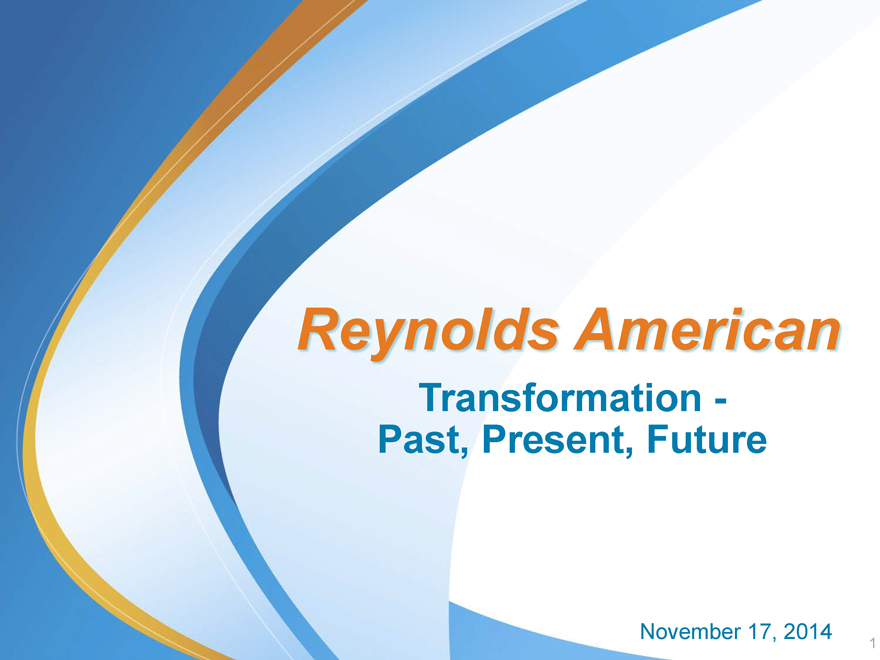
Reynolds American
Past, Transformation Present, Future —
November 17, 2014
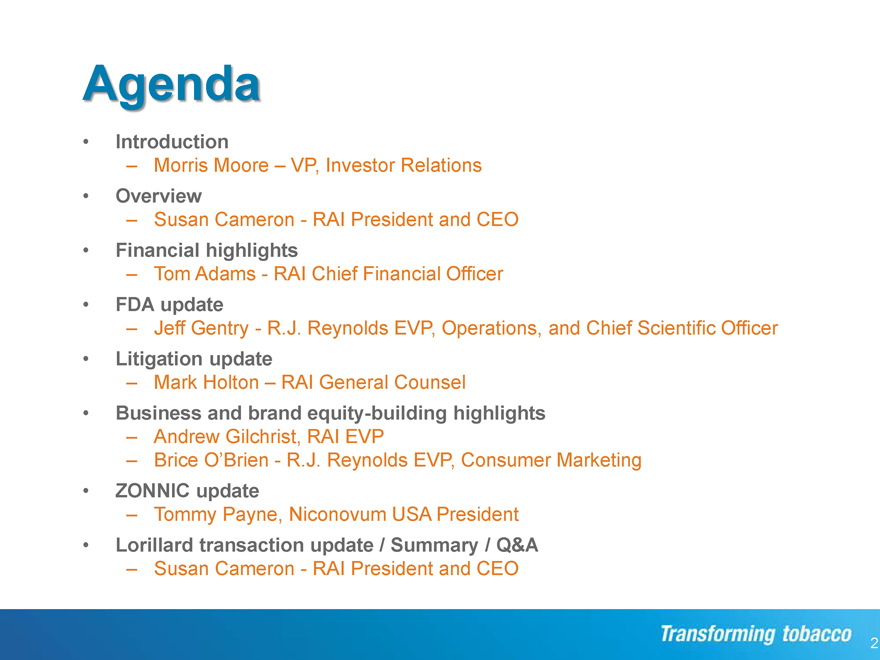
Agenda
Introduction
– Morris Moore – VP, Investor Relations
Overview
– Susan Cameron—RAI President and CEO
Financial highlights
– Tom Adams—RAI Chief Financial Officer
FDA update
– Jeff Gentry—R.J. Reynolds EVP, Operations, and Chief Scientific Officer
Litigation update
– Mark Holton – RAI General Counsel
Business and brand equity-building highlights
– Andrew Gilchrist, RAI EVP
– Brice O’Brien—R.J. Reynolds EVP, Consumer Marketing
ZONNIC update
– Tommy Payne, Niconovum USA President
Lorillard transaction update / Summary / Q&A
– Susan Cameron—RAI President and CEO
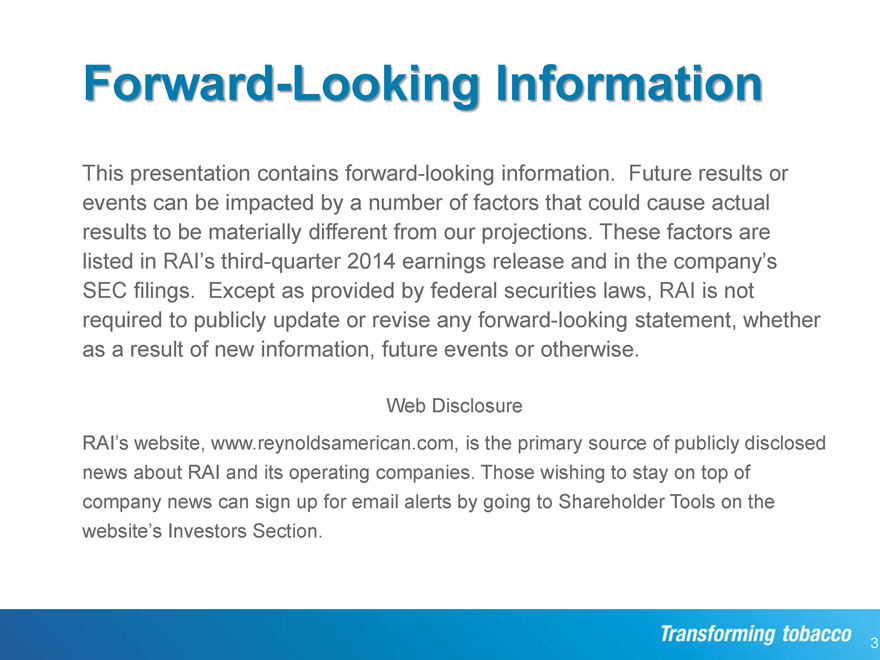
Forward-Looking Information
This presentation contains forward-looking information. Future results or events can be impacted by a number of factors that could cause actual results to be materially different from our projections. These factors are listed in RAI’s third-quarter 2014 earnings release and in the company’s SEC filings. Except as provided by federal securities laws, RAI is not required to publicly update or revise any forward-looking statement, whether as a result of new information, future events or otherwise.
Web Disclosure
RAI’s website, www.reynoldsamerican.com, is the primary source of publicly disclosed news about RAI and its operating companies. Those wishing to stay on top of company news can sign up for email alerts by going to Shareholder Tools on the website’s Investors Section.
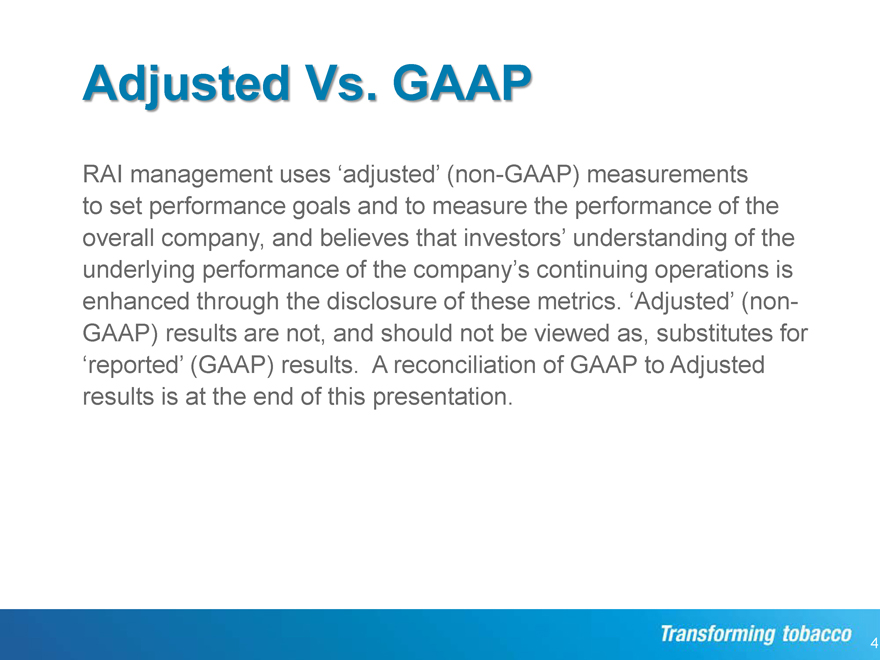
Adjusted Vs. GAAP
RAI management uses ‘adjusted’ (non-GAAP) measurements to set performance goals and to measure the performance of the overall company, and believes that investors’ understanding of the underlying performance of the company’s continuing operations is enhanced through the disclosure of these metrics. ‘Adjusted’ (non-GAAP) results are not, and should not be viewed as, substitutes for ‘reported’ (GAAP) results. A reconciliation of GAAP to Adjusted results is at the end of this presentation.
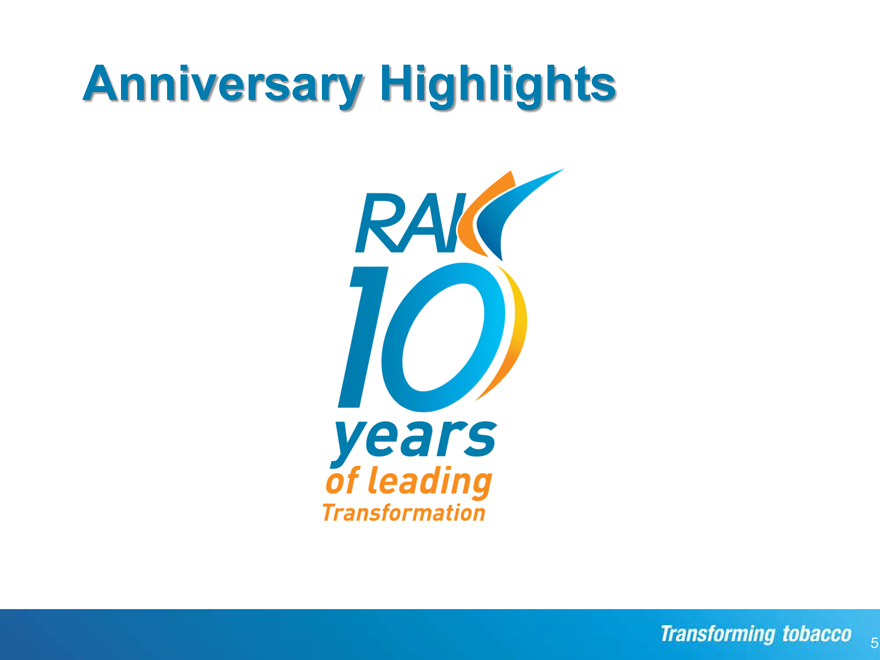
Anniversary Highlights
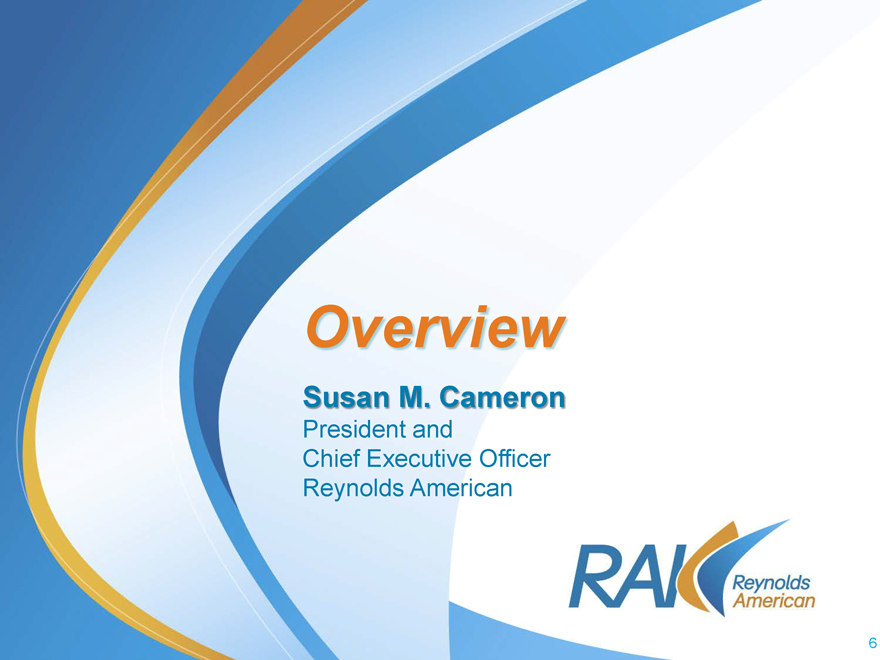
Overview
Susan M. Cameron
President and Chief Executive Officer Reynolds American
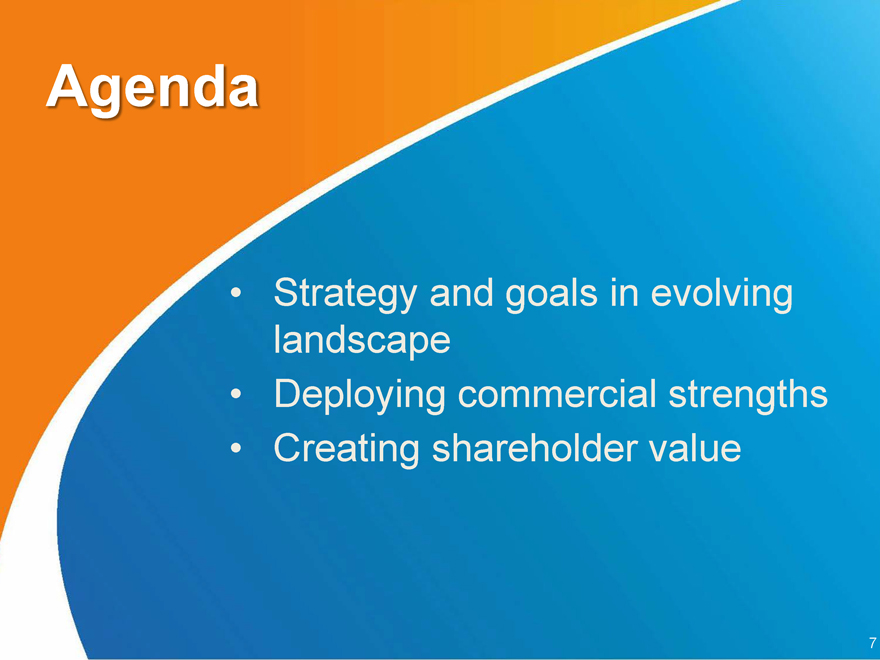
Agenda
Strategy and goals in evolving landscape
Deploying commercial strengths
Creating shareholder value
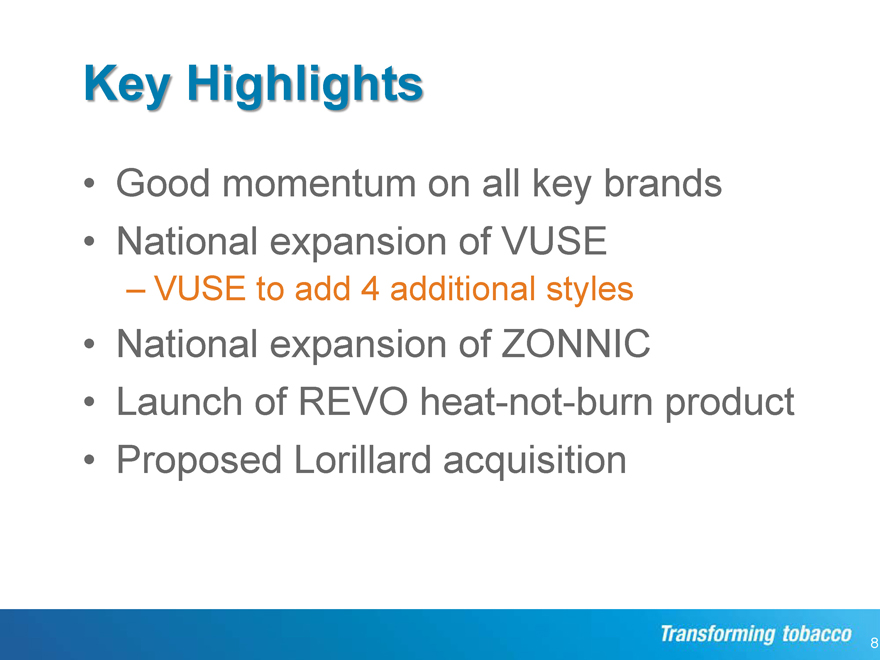
Key Highlights
Good momentum on all key brands
National expansion of VUSE
– VUSE to add 4 additional styles
National expansion of ZONNIC
Launch of REVO heat-not-burn product
Proposed Lorillard acquisition
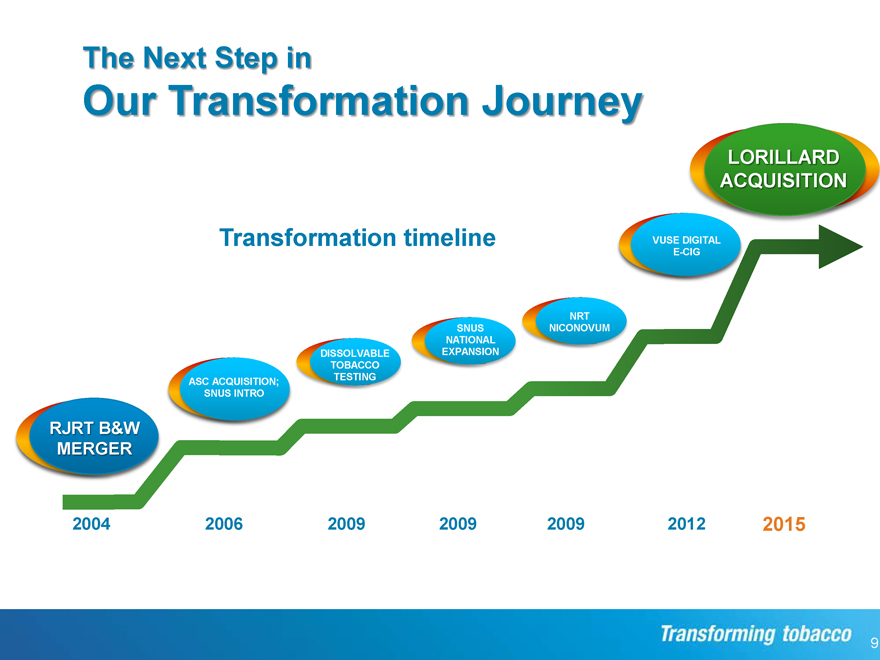
The Next Step in
Our Transformation Journey
LORILLARD
ACQUISITION
Transformation timeline VUSE DIGITAL
E-CIG
NRT
SNUS NICONOVUM
NATIONAL
DISSOLVABLE EXPANSION
TOBACCO
ASC ACQUISITION; TESTING
SNUS INTRO
RJRT B&W
MERGER
2004 2006 2009 2009 2009 2012 2015
9
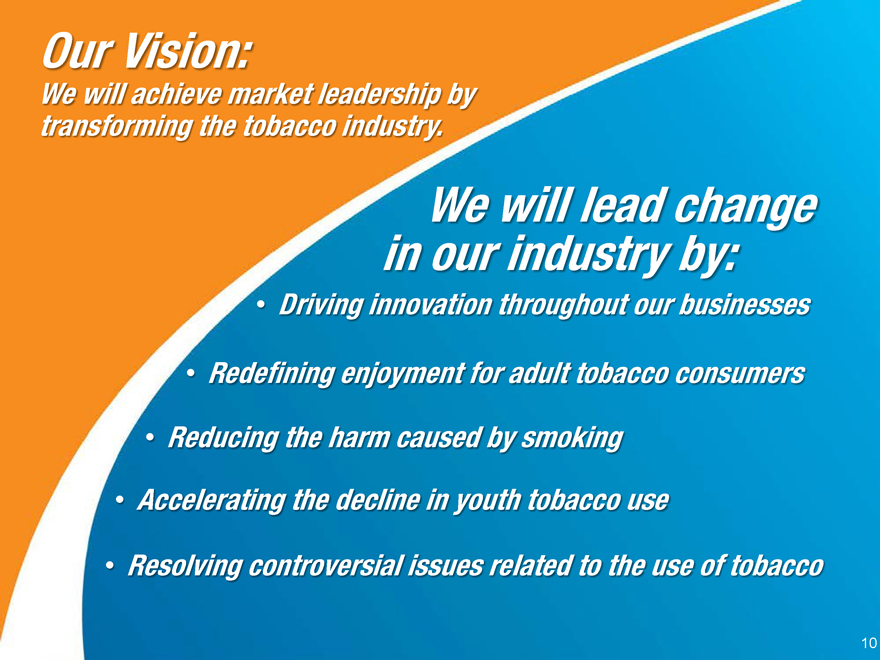
Our Vision:
We will achieve market leadership by transforming the tobacco industry.
We will lead change in our industry by:
Driving innovation throughout our businesses
Redefining enjoyment for adult tobacco consumers
Reducing the harm caused by smoking
Accelerating the decline in youth tobacco use
Resolving controversial issues related to the use of tobacco
10
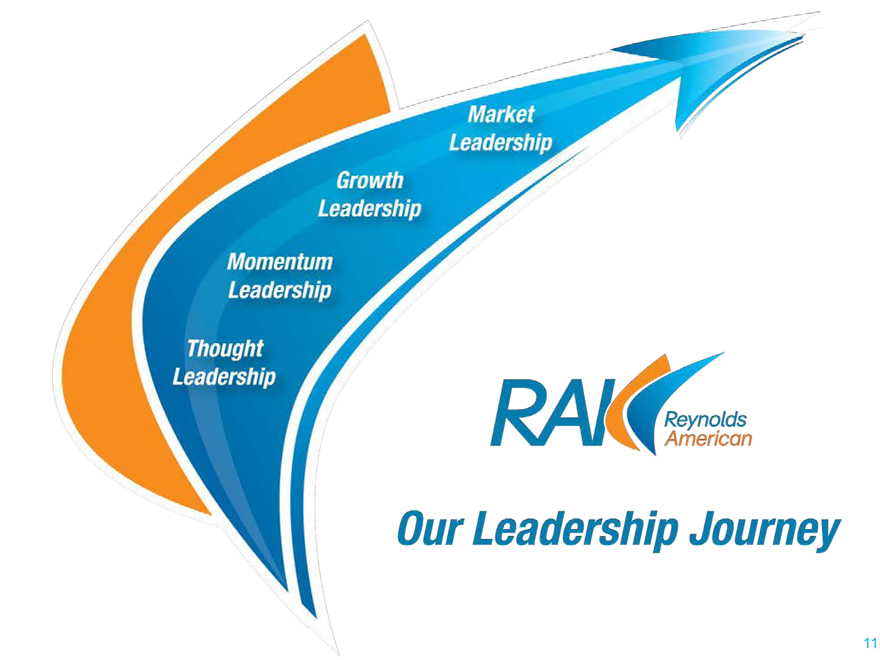
Our Leadership Journey
11
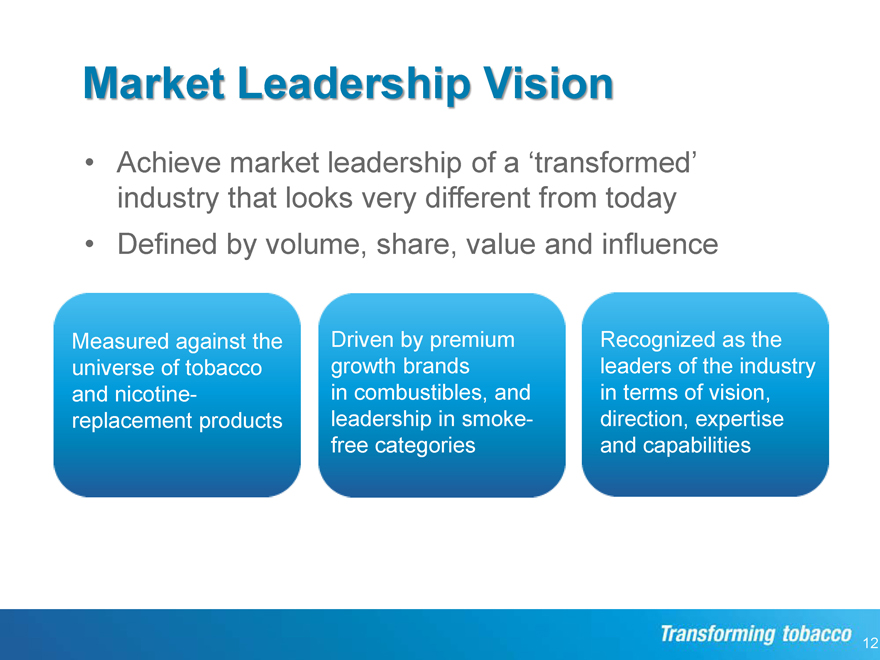
Market Leadership Vision
Achieve market leadership of a ‘transformed’ industry that looks very different from today
Defined by volume, share, value and influence
Measured against the universe of tobacco and nicotine-replacement products
Driven by premium growth brands in combustibles, and leadership in smoke-free categories
Recognized as the leaders of the industry in terms of vision, direction, expertise and capabilities
12
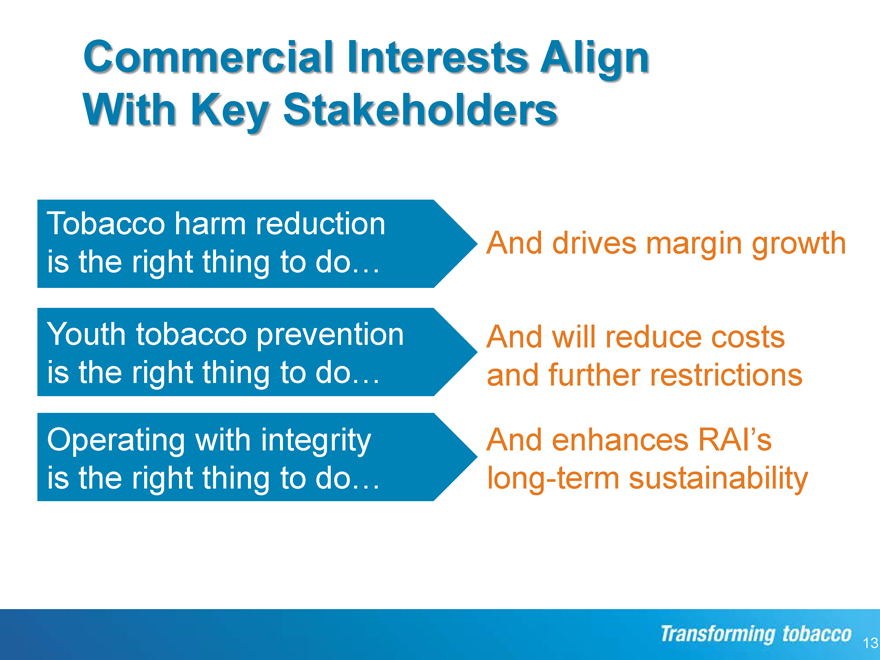
Commercial Interests Align With Key Stakeholders
Tobacco harm reduction is the right thing to do… Youth tobacco prevention is the right thing to do… Operating with integrity is the right thing to do…
And drives margin growth
And will reduce costs and further restrictions And enhances RAI’s long-term sustainability
13
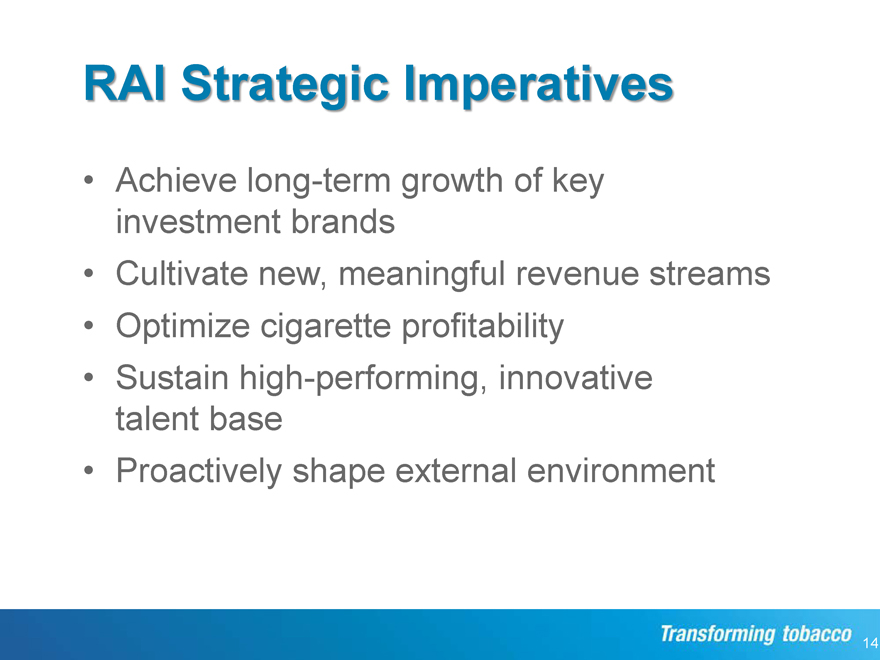
RAI Strategic Imperatives
Achieve long-term growth of key investment brands
Cultivate new, meaningful revenue streams
Optimize cigarette profitability
Sustain high-performing, innovative talent base
Proactively shape external environment
14
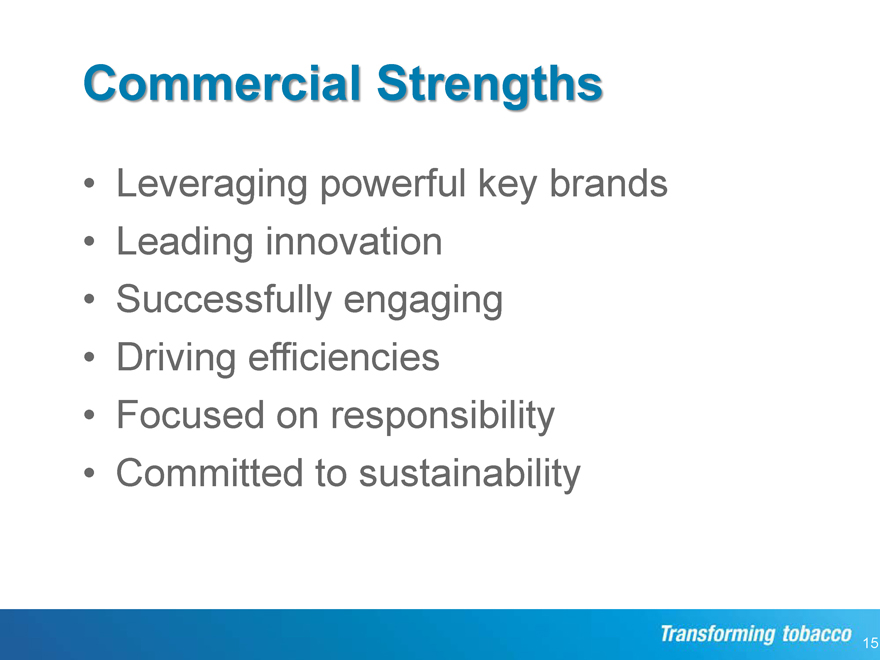
Commercial Strengths
Leveraging powerful key brands
Leading innovation
Successfully engaging
Driving efficiencies
Focused on responsibility
Committed to sustainability
15
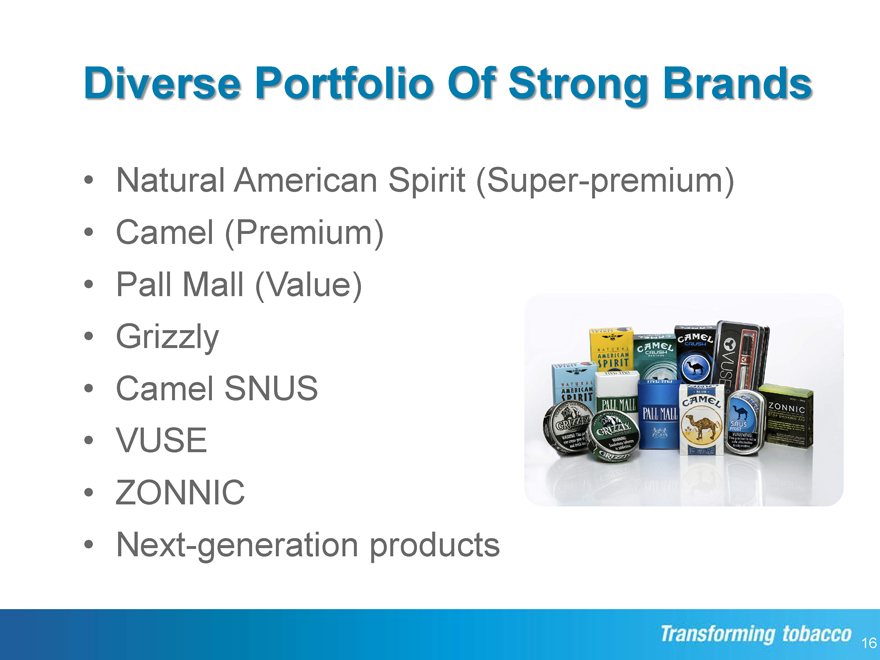
Diverse Portfolio Of Strong Brands
Natural American Spirit (Super-premium)
Camel (Premium)
Pall Mall (Value)
Grizzly
Camel SNUS
VUSE
ZONNIC
Next-generation products
16
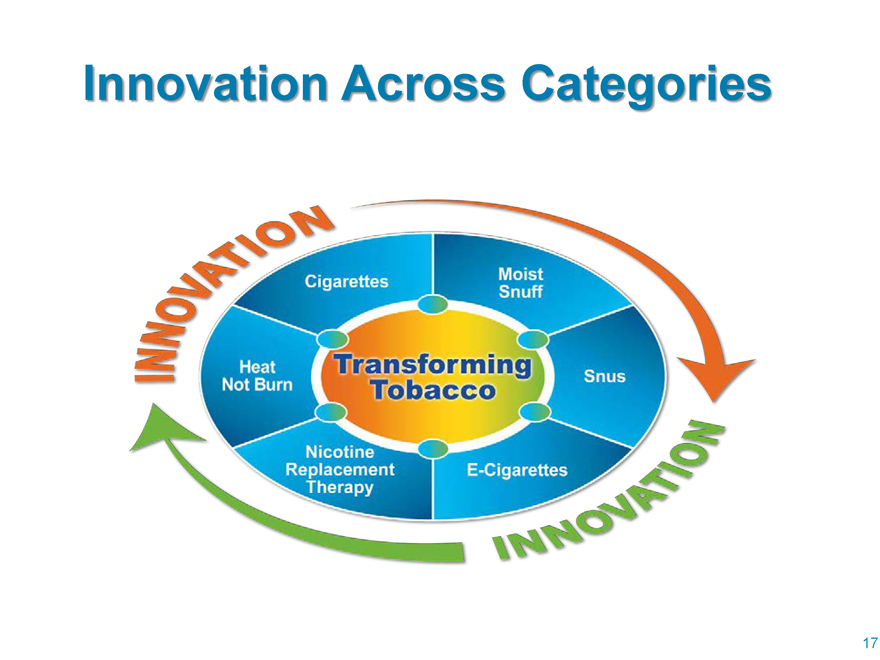
Innovation Across Categories
17
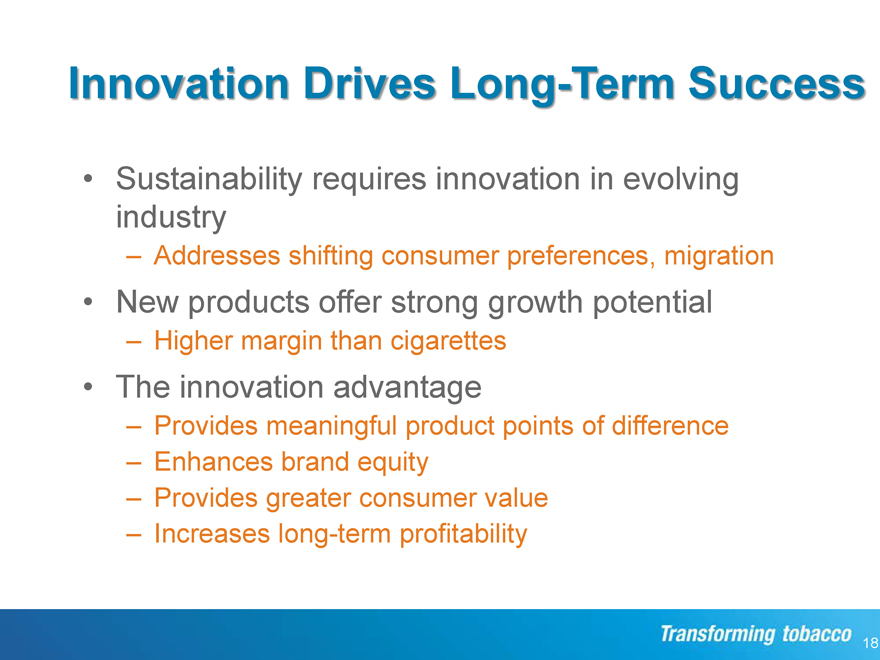
Innovation Drives Long-Term Success
Sustainability requires innovation in evolving industry
– Addresses shifting consumer preferences, migration
New products offer strong growth potential
– Higher margin than cigarettes
The innovation advantage
– Provides meaningful product points of difference
– Enhances brand equity
– Provides greater consumer value
– Increases long-term profitability
18
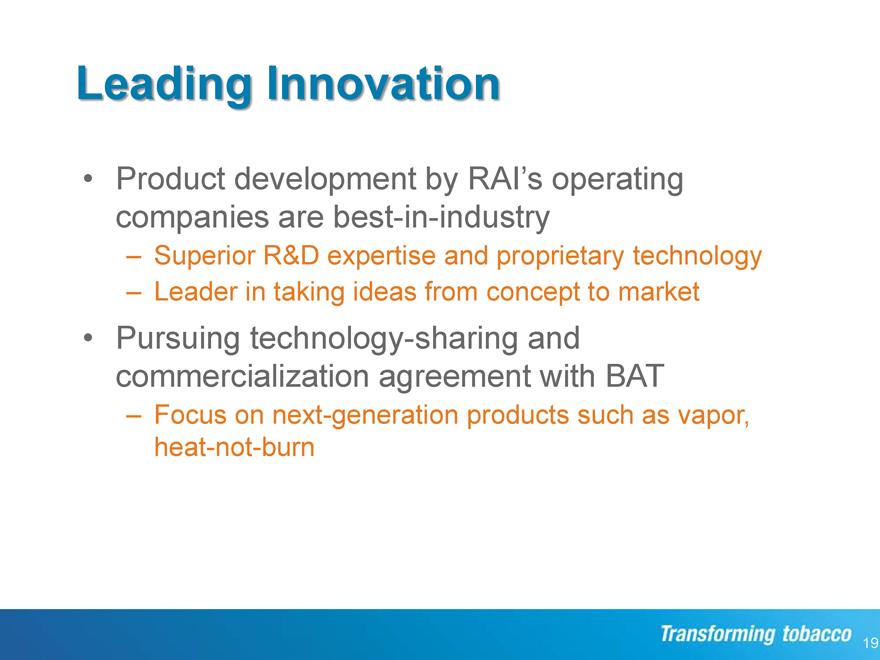
Leading Innovation
Product development by RAI’s operating companies are best-in-industry
– Superior R&D expertise and proprietary technology
– Leader in taking ideas from concept to market
Pursuing technology-sharing and commercialization agreement with BAT
– Focus on next-generation products such as vapor, heat-not-burn
19
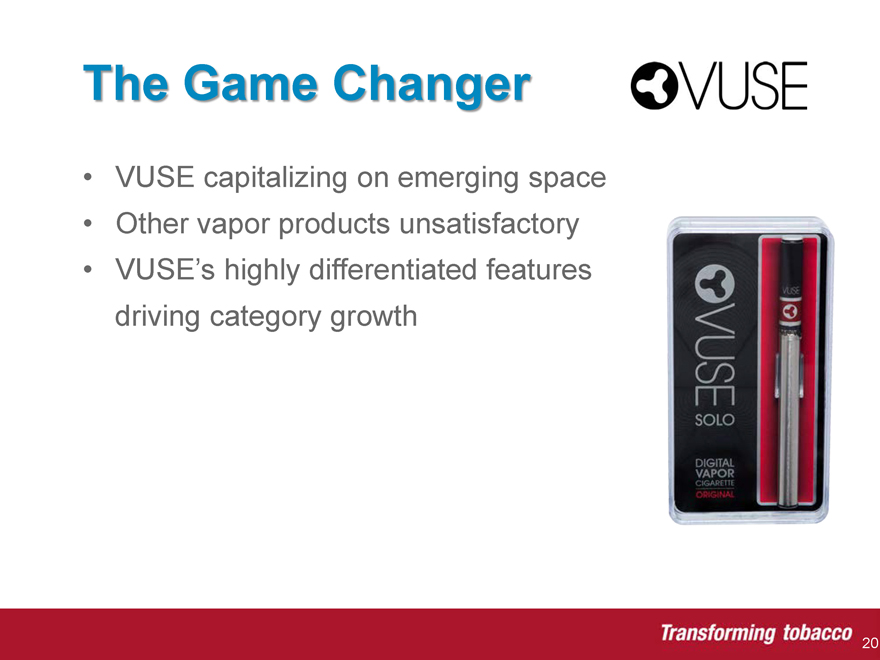
The Game Changer
VUSE capitalizing on emerging space
Other vapor products unsatisfactory
VUSE’s highly differentiated features driving category growth
20
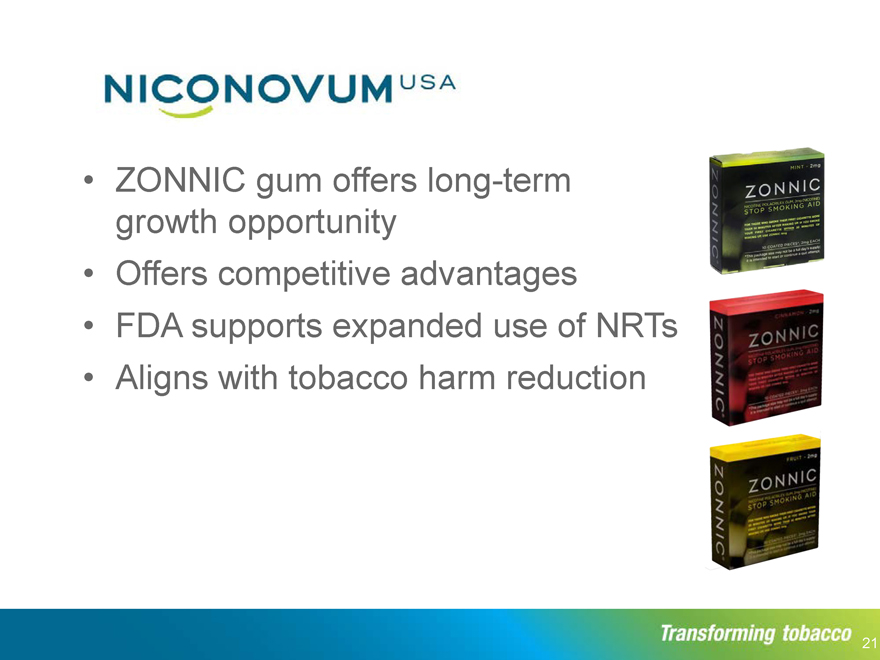
ZONNIC gum offers long-term growth opportunity
Offers competitive advantages
FDA supports expanded use of NRTs
Aligns with tobacco harm reduction
21
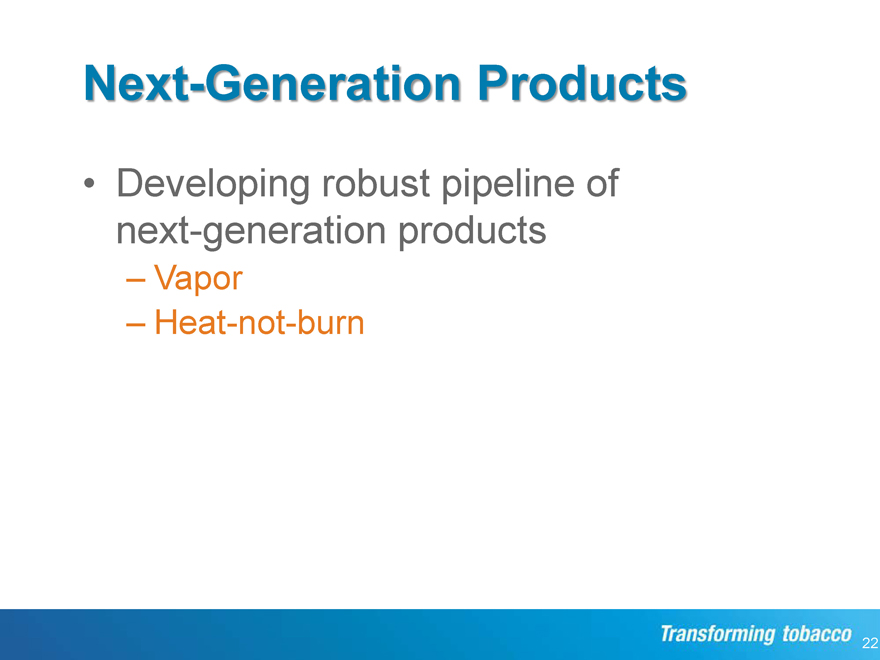
Next-Generation Products
Developing robust pipeline of next-generation products
– Vapor
– Heat-not-burn
22
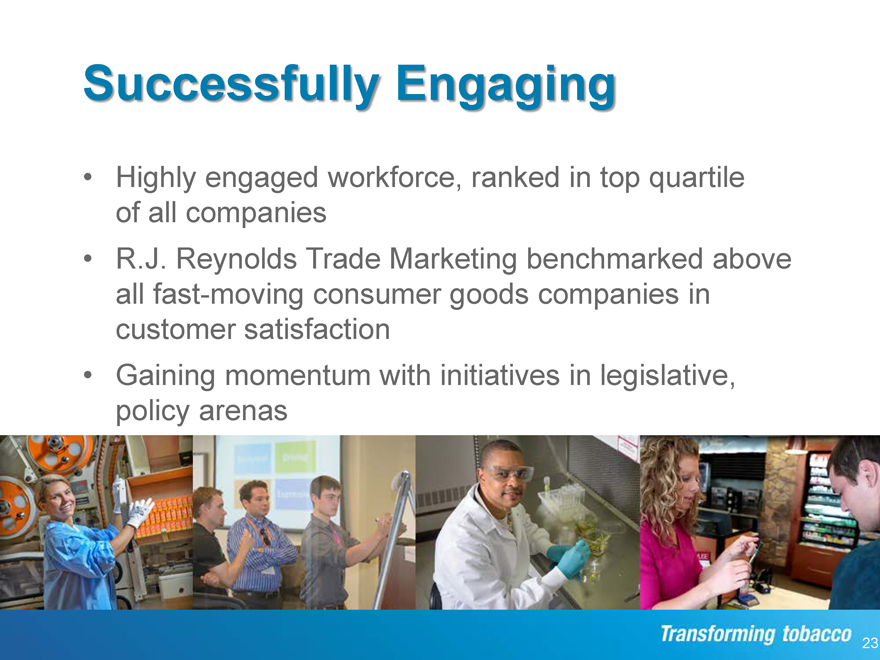
Successfully Engaging
Highly engaged workforce, ranked in top quartile of all companies
R.J. Reynolds Trade Marketing benchmarked above all fast-moving consumer goods companies in customer satisfaction
Gaining momentum with initiatives in legislative, policy arenas
23
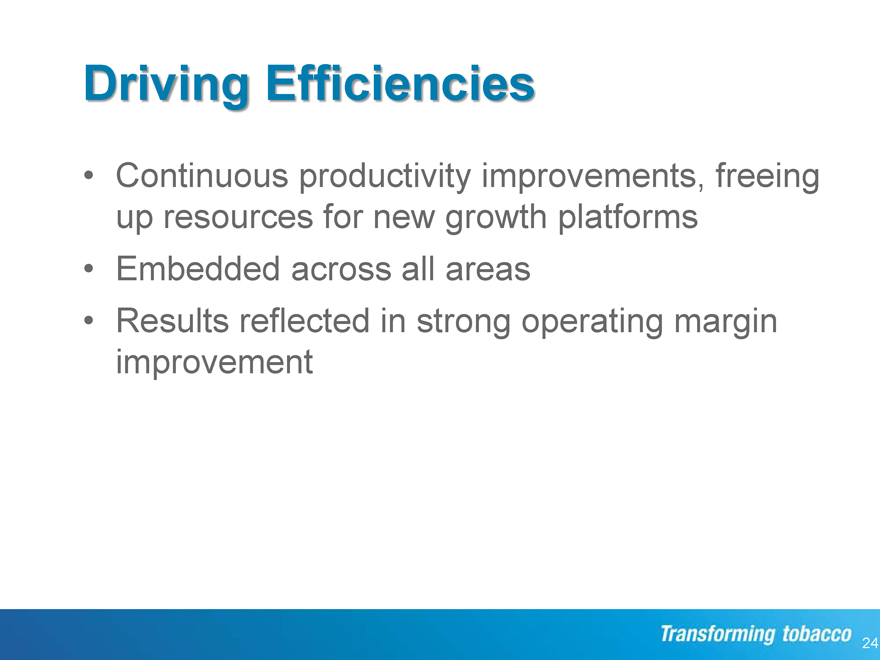
Driving Efficiencies
Continuous productivity improvements, freeing up resources for new growth platforms
Embedded across all areas
Results reflected in strong operating margin improvement
24
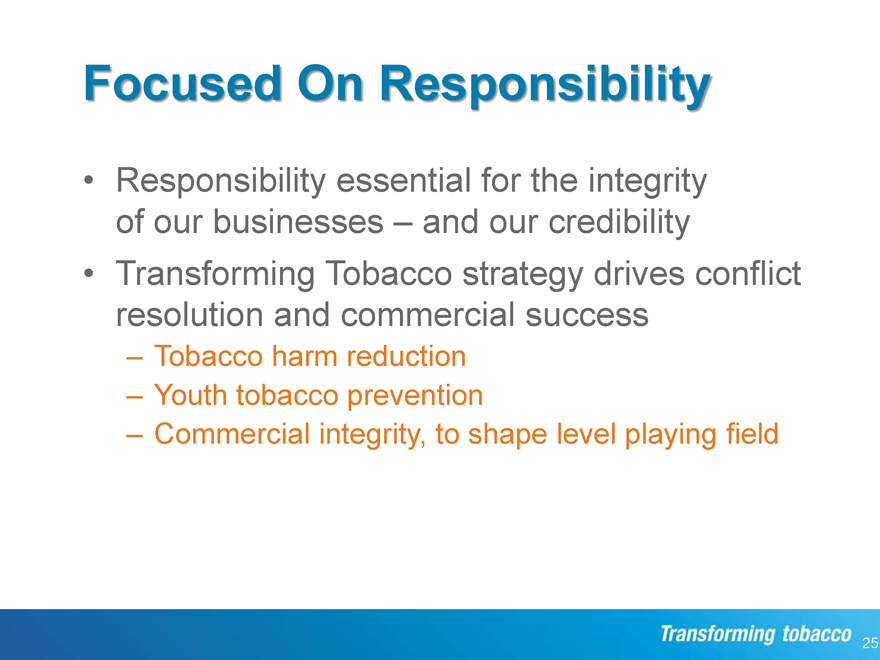
Focused On Responsibility
Responsibility essential for the integrity of our businesses – and our credibility
Transforming Tobacco strategy drives conflict resolution and commercial success
– Tobacco harm reduction
– Youth tobacco prevention
– Commercial integrity, to shape level playing field
25
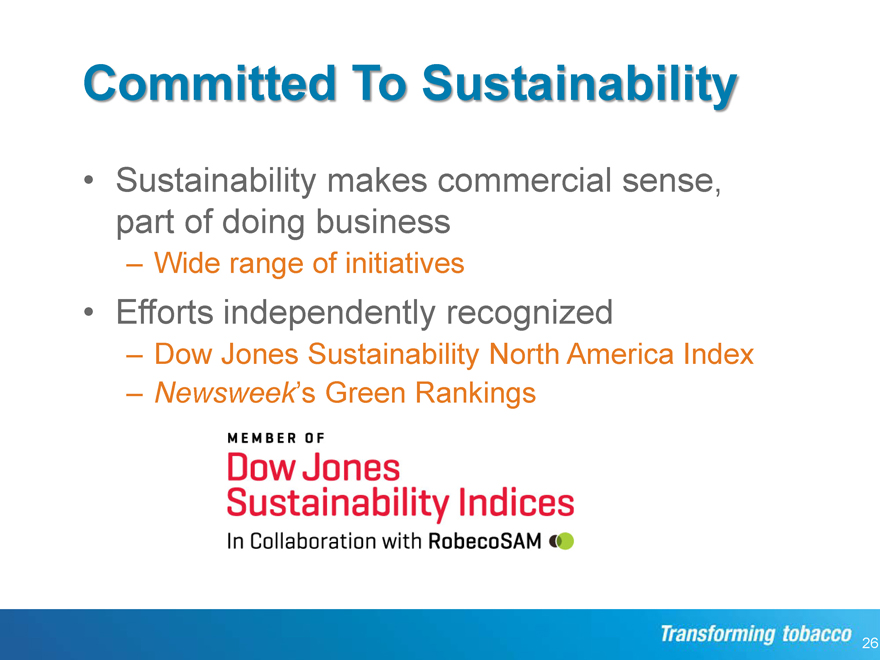
Committed To Sustainability
Sustainability makes commercial sense, part of doing business
– Wide range of initiatives
Efforts independently recognized
– Dow Jones Sustainability North America Index
– Newsweek’s Green Rankings
26
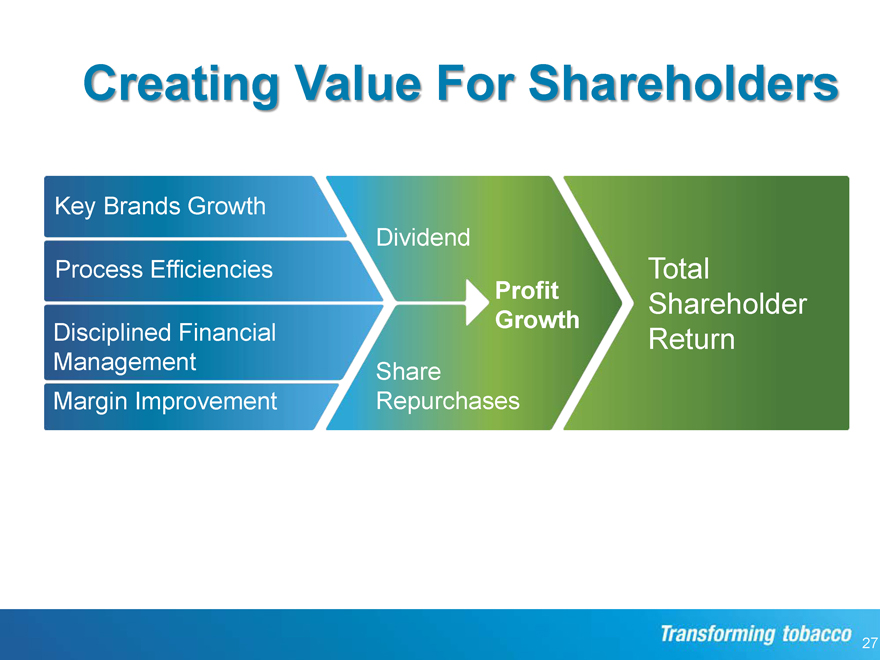
Creating Value For Shareholders
Key Brands Growth
Dividend
Process Efficiencies Total
Profit Shareholder
Growth
Disciplined Financial Return
Management Share
Margin Improvement Repurchases
27
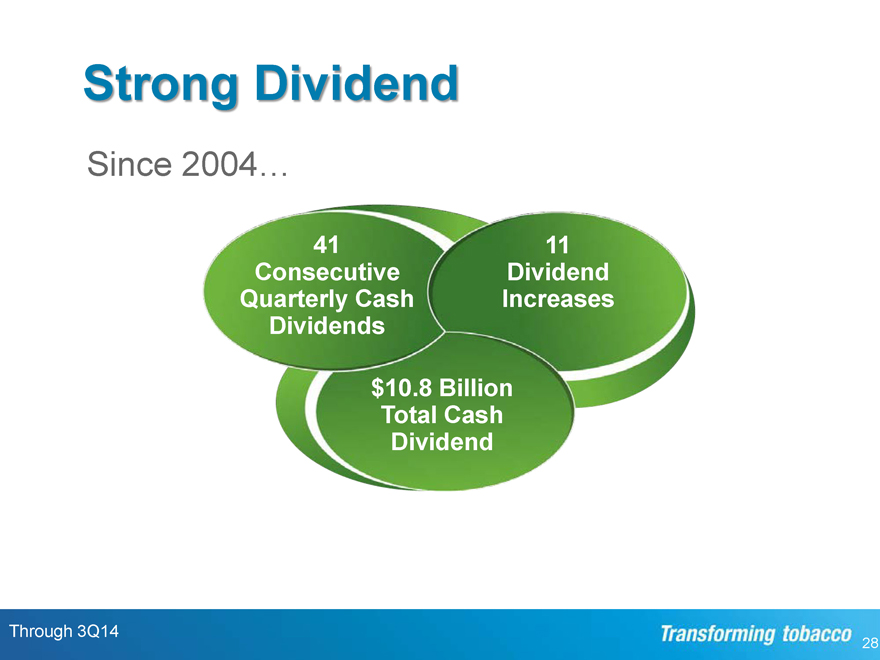
Strong Dividend
Since 2004…
41 11
Consecutive Dividend
Quarterly Cash Increases
Dividends
$10.8 Billion
Total Cash
Dividend
Through 3Q14
28
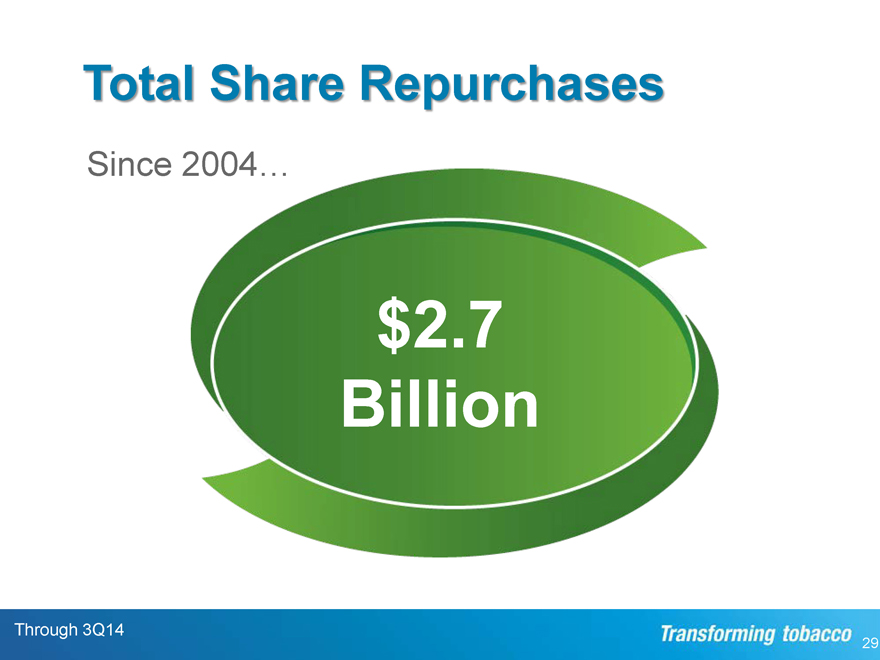
Total Share Repurchases
Since 2004…
$2.7 Billion
Through 3Q14
29
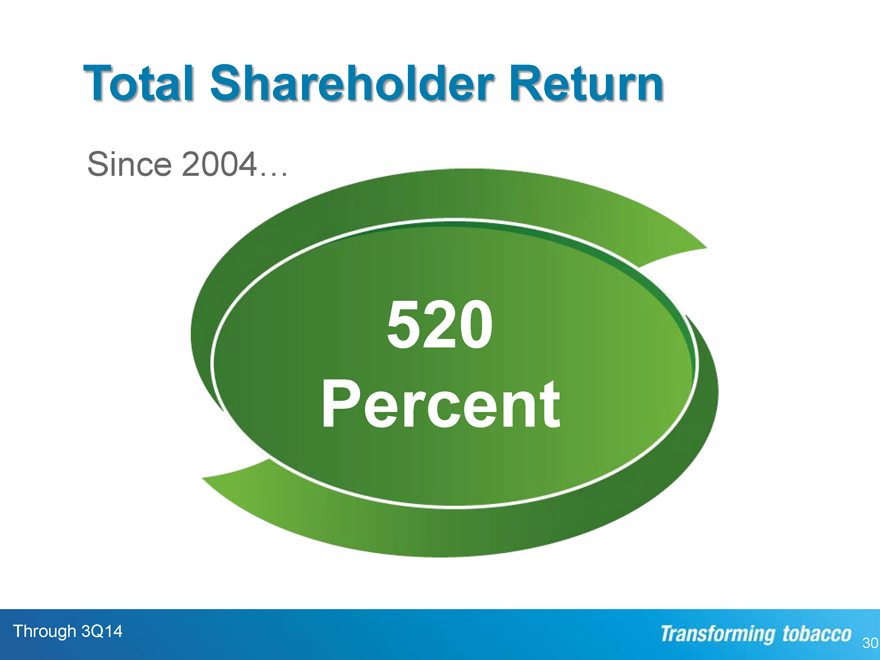
Total Shareholder Return
Since 2004…
520 Percent
Through 3Q14
30
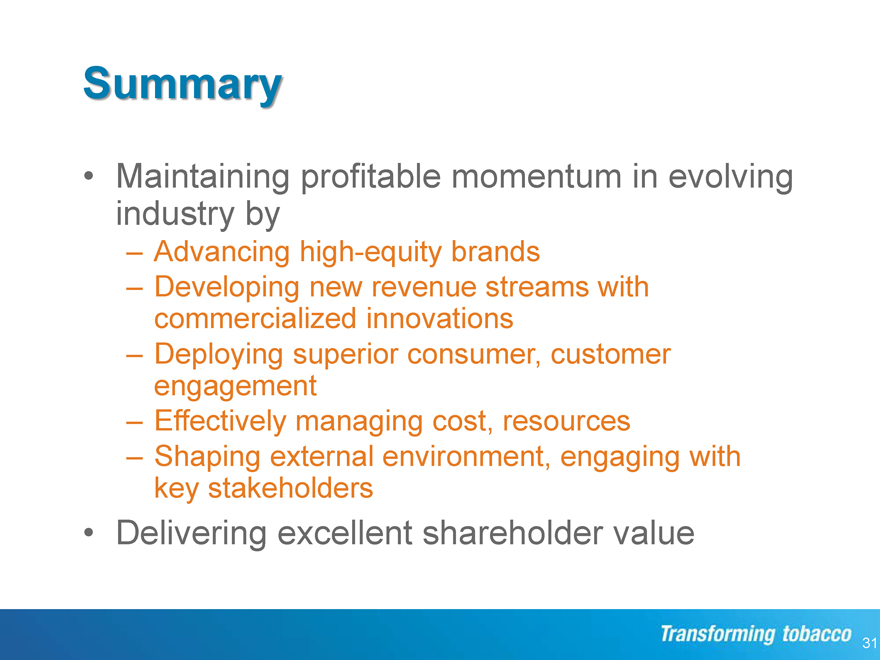
Summary
Maintaining profitable momentum in evolving industry by
– Advancing high-equity brands
– Developing new revenue streams with commercialized innovations
– Deploying superior consumer, customer engagement
– Effectively managing cost, resources
– Shaping external environment, engaging with key stakeholders
Delivering excellent shareholder value
31
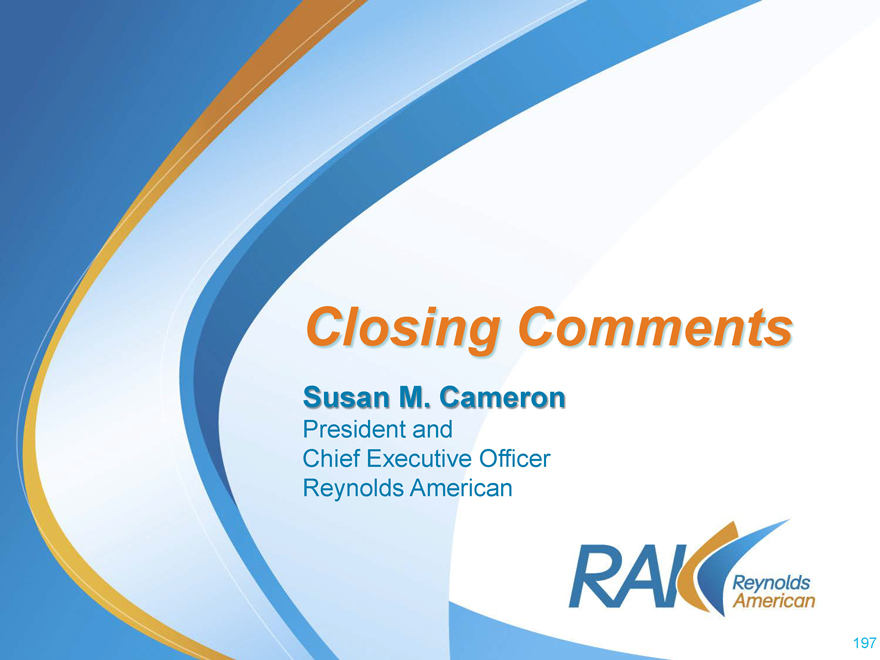
Closing Comments
Susan M. Cameron
President and Chief Executive Officer Reynolds American
197
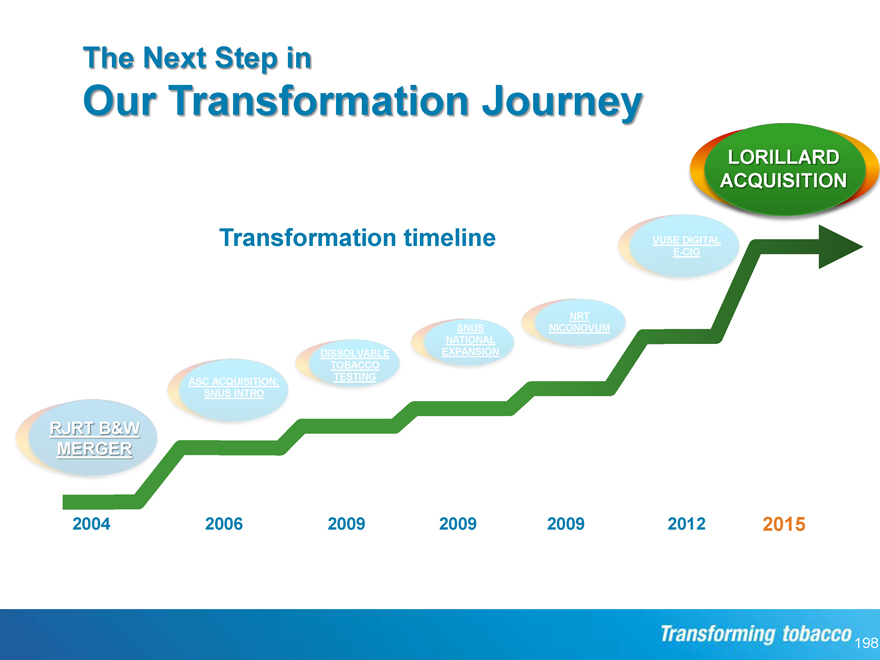
The Next Step in
Our Transformation Journey
LORILLARD
ACQUISITION
Transformation timeline VUSE DIGITAL
E-CIG
NRT
SNUS NICONOVUM
NATIONAL
DISSOLVABLE EXPANSION
TOBACCO
ASC ACQUISITION; TESTING
SNUS INTRO
RJRT B&W
MERGER
2004 2006 2009 2009 2009 2012 2015
198
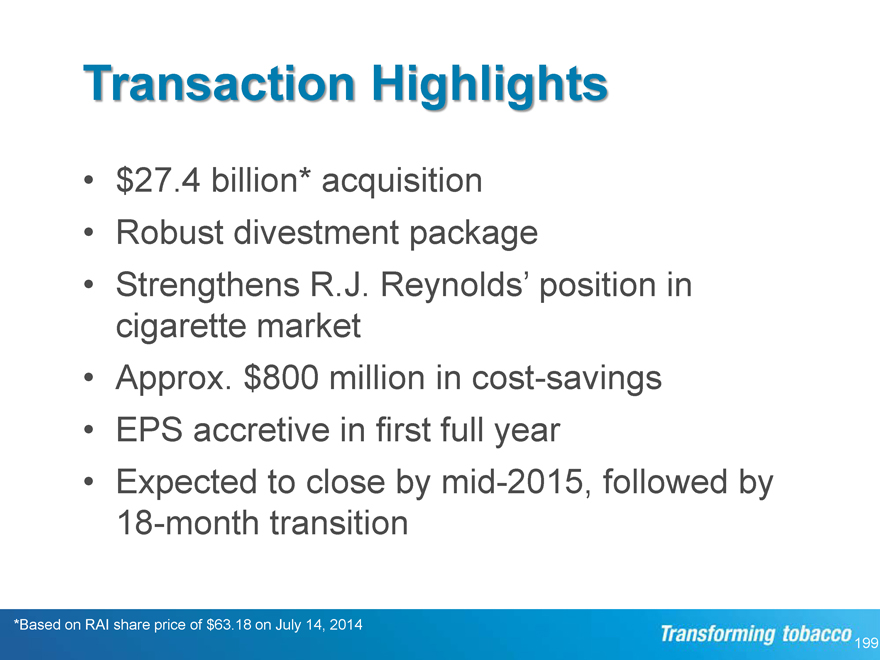
Transaction Highlights
$27.4 billion* acquisition
Robust divestment package
Strengthens R.J. Reynolds’ position in cigarette market
Approx. $800 million in cost-savings
EPS accretive in first full year
Expected to close by mid-2015, followed by 18-month transition
*Based on RAI share price of $63.18 on July 14, 2014
199
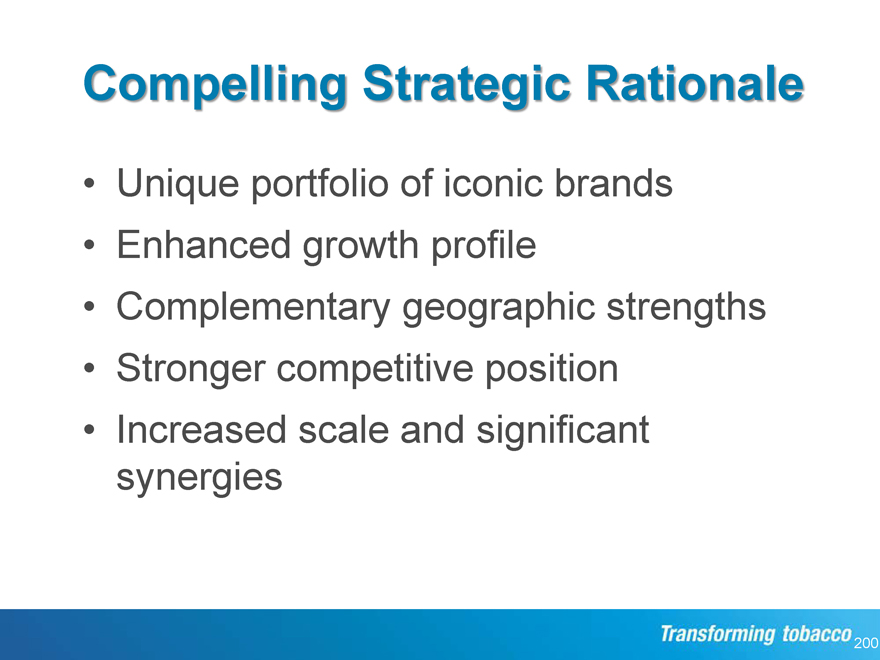
Compelling Strategic Rationale
Unique portfolio of iconic brands
Enhanced growth profile
Complementary geographic strengths
Stronger competitive position
Increased scale and significant synergies
200
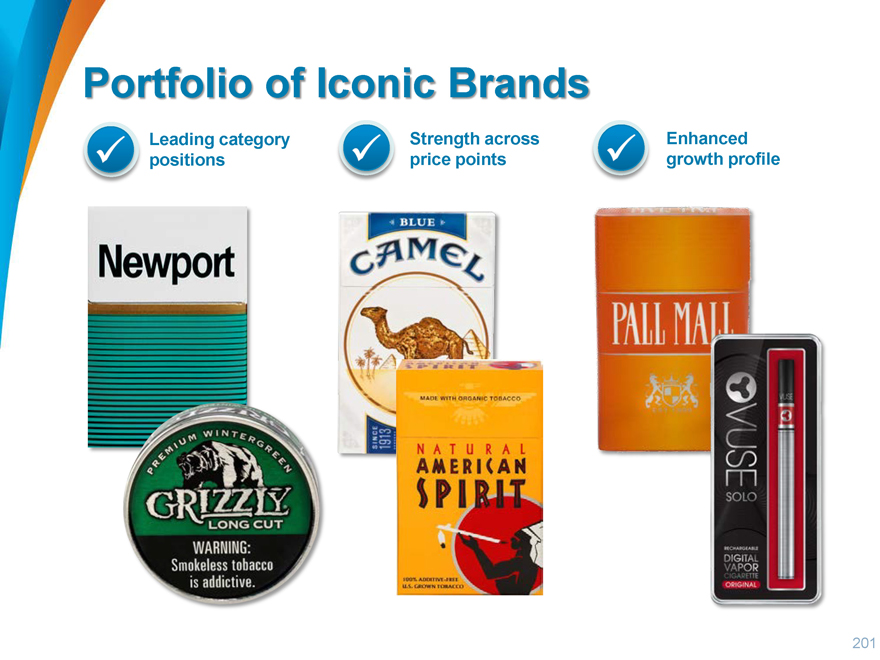
Portfolio of Iconic Brands
Leading category Strength across Enhanced positions price points growth profile
201
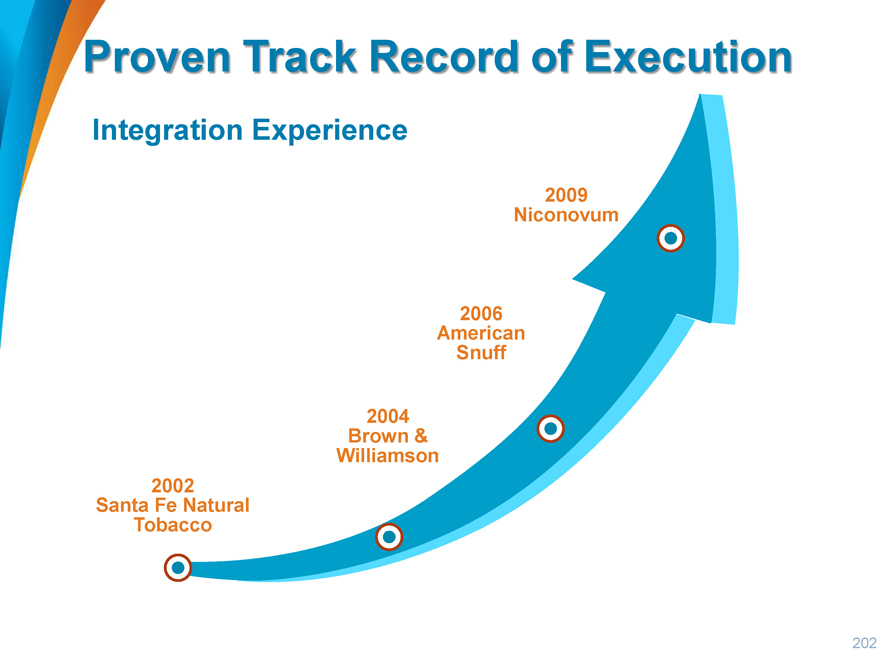
Proven Track Record of Execution
Integration Experience
2009
Niconovum
2006
American
Snuff
2004
Brown &
Williamson
2002
Santa Fe Natural
Tobacco
202
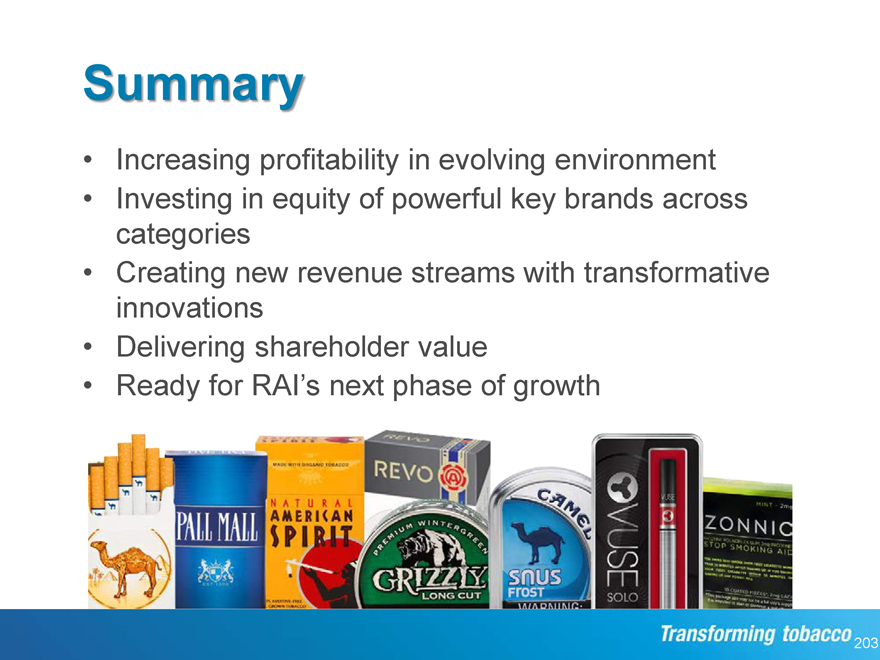
Summary
Increasing profitability in evolving environment
Investing in equity of powerful key brands across categories
Creating new revenue streams with transformative innovations
Delivering shareholder value
Ready for RAI’s next phase of growth
203
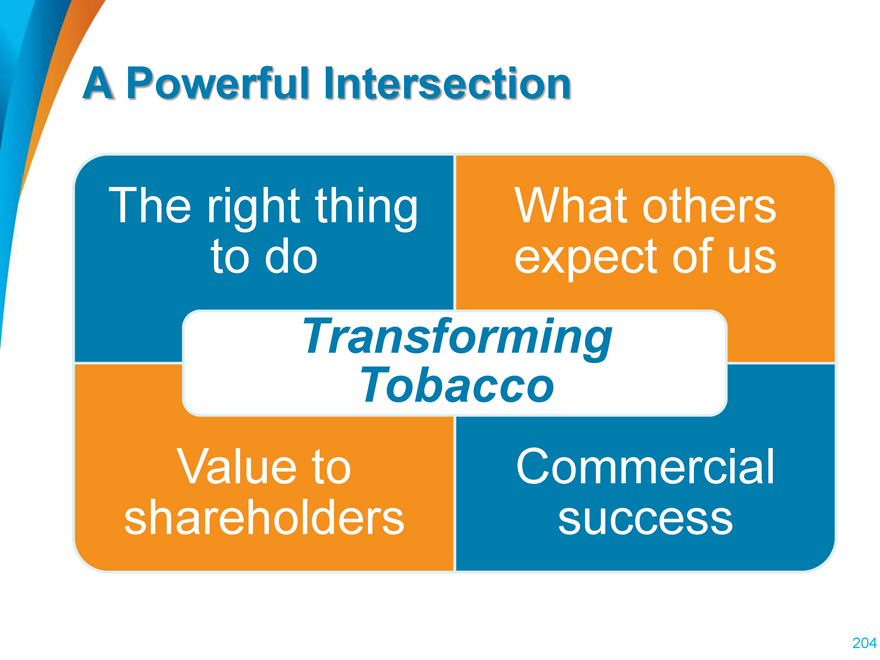
A Powerful Intersection
The right thing What others
to do expect of us
Transforming
Tobacco
Value to Commercial
shareholders success
204
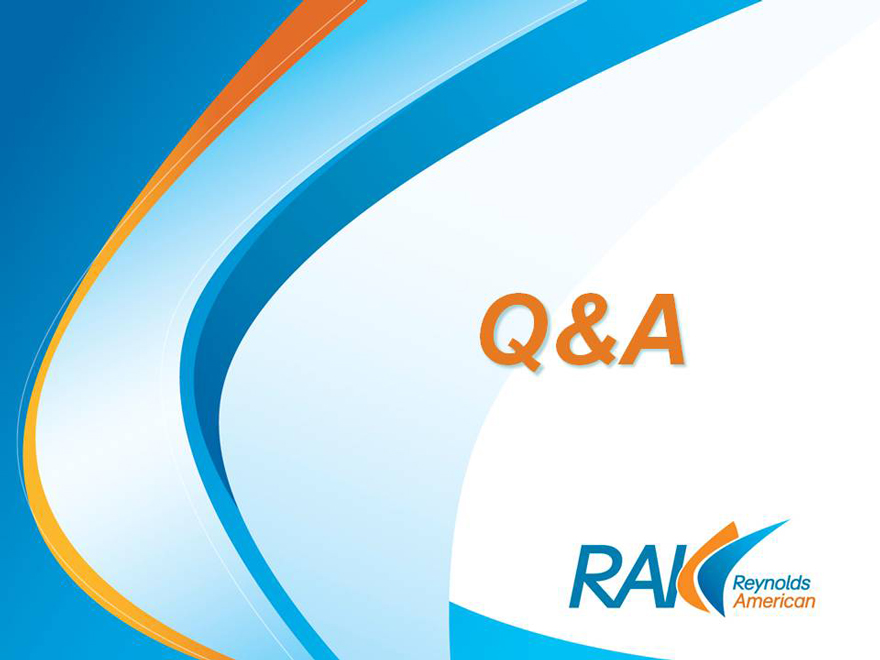
Q&A
*****
Cautionary Statement Regarding Forward-Looking Statements
Statements included in this communication that are not historical in nature constitute forward-looking statements made pursuant to the safe harbor provisions of the Private Securities Litigation Reform Act of 1995. When used in this communication and in documents incorporated by reference, forward-looking statements include, without limitation, statements regarding the benefits of the Proposed Transactions, including future financial and operating results, the combined company’s plans, expectations, beliefs, intentions and future strategies, and other statements that are not historical facts, that are signified by the words “anticipate,” “believe,” “estimate,” “expect,” “intend,” “may,” “objective,” “outlook,” “plan,” “project,” “possible,” “potential,” “should” and similar expressions. These statements regarding future events or the future performance or results of the combined company inherently are subject to a variety of risks, contingencies and uncertainties that could cause actual results, performance or achievements to differ materially from those described in or implied in the forward-looking statements.
Among the risks, contingencies and uncertainties that could cause actual results to differ from those described in the forward-looking statements or could result in the failure of the of the proposed transactions (the Proposed Transactions), relating to the consummation of the previously announced Proposed Transactions with Reynolds American, Lorillard, Inc. (Lorillard), Imperial Tobacco Group PLC (Imperial), Lignum-2, L.L.C. (Imperial Sub), a wholly owned subsidiary of Imperial, and British American Tobacco p.l.c. (BAT), to be consummated or, if consummated, could have an adverse effect on the results of operations, cash flows and financial position of Reynolds American, are the following: the failure to obtain necessary regulatory or other approvals for the Proposed Transactions, or if obtained, the possibility of being subjected to conditions that could reduce the expected synergies and other benefits of the Proposed Transactions, result in a material delay in, or the abandonment of, the Proposed Transactions or otherwise have an adverse effect on Reynolds American; the obligation to complete the Proposed Transactions even if financing is not available or is available on terms other than those currently anticipated, including financing less favorable to Reynolds American than its current commitments, due to the absence of a financing condition in connection with the Proposed Transactions; the obligation to complete the Proposed Transactions even if there are adverse governmental developments with respect to menthol in cigarettes, and, once completed, the effect of such adverse governmental developments on Reynolds American’s subsidiaries’ sales of products that contain menthol which will represent a substantial portion of Reynolds American’s consolidated sales; the failure to satisfy required closing conditions or complete the Proposed Transactions in a timely manner; the failure to obtain necessary shareholder approvals for the Proposed Transactions; the failure to obtain Imperial shareholder approval for the divestiture transaction and the possibility of needing an alternative divestiture partner; the possibility of selling the transferred assets, including the brands currently expected to be divested, or which otherwise might be divested (in each case, subject to Reynolds American’s binding obligations under the asset purchase agreement to complete the divestiture transaction), on terms less favorable than the divestiture transaction, due to the absence of a condition in connection with the Proposed Transactions be completed; the possibility of
having to include RJR Tobacco’s DORAL brand as part of the divestiture transaction; the effect of the announcement of the Proposed Transactions on the ability to retain and hire key personnel, maintain business relationships, and on operating results and businesses generally; the effect of restrictions placed on Reynolds American’s, Lorillard’s or their respective subsidiaries’ business activities and the limitations put on Reynolds American’s and Lorillard’s ability to pursue alternatives to the Proposed Transactions pursuant to the merger agreement and the asset purchase agreement; the possibility of delay or prevention of the Proposed Transactions by lawsuits challenging the Proposed Transactions filed against Reynolds American, the members of the Reynolds American board of directors, Lorillard, the members of the Lorillard board of directors and BAT; the uncertainty of the value of the merger consideration that Lorillard shareholders will receive in the Proposed Transactions due to a fixed exchange ratio and a potential fluctuation in the market price of Reynolds American common stock; the reliance of RJR Tobacco on Imperial Sub to manufacture Newport on RJR Tobacco’s behalf for a period of time after the divestiture transaction; Reynolds American’s obligations to indemnify Imperial Sub for specified matters and to retain certain liabilities related to the transferred assets; the possibility of Reynolds American’s and Lorillard’s directors and officers having interests in the Proposed Transactions that are different from, or in addition to, the interests of Reynolds American and Lorillard shareholders generally; the possibility of changes in circumstances between the date of the signing of the merger agreement and the closing of the Proposed Transactions that will not be reflected in the fairness opinions obtained by the boards of directors of Reynolds American and Lorillard from their respective advisors; a termination of the governance agreement or certain provisions of it in accordance with its terms, including the limitations on Brown & Williamson Holdings, Inc.’s (B&W) representation on the Reynolds American board of directors and its board committees; the effect of the substantial additional indebtedness that Reynolds American will incur in connection with the Proposed Transactions; the continuing decline in volume in the U.S. cigarette industry and Reynolds American’s dependence on the U.S. cigarette industry; the impact of BAT’s significant beneficial ownership in Reynolds American, the related governance agreement among Reynolds American, BAT and B&W and the provisions favoring BAT in the Reynolds American articles of incorporation on Reynolds American’s business, the Reynolds American board of directors and other Reynolds American shareholders; the possibility of actual results of operations, cash flows and financial position after the Proposed Transactions materially differing from the Reynolds American unaudited pro forma condensed combined financial statements; the difference in rights provided to Lorillard shareholders under Delaware law, the Lorillard certificate of incorporation and the Lorillard by-laws, as compared to the rights Lorillard shareholders will obtain as Reynolds American shareholders under North Carolina law, the Reynolds American articles of incorporation, the Reynolds American bylaws and the governance agreement; the failure to realize projected synergies and other benefits from the Proposed Transactions; the incurrence of significant pre- and post-transaction related costs in connection with the Proposed Transactions; and the occurrence of any event giving rise to the right of a party to terminate the Proposed Transactions. Discussions of additional risks, contingencies and uncertainties are contained in Reynolds American’s and Lorillard’s filings with the Securities and Exchange Commission (the SEC).
Due to these risks, contingencies and other uncertainties, you are cautioned not to place undue reliance on these forward-looking statements, which speak only as of the date of such statements. Except as provided by federal securities laws, Reynolds American is under no obligation to, and expressly disclaims any obligation, to update, alter or otherwise revise any forward-looking statements, whether written or oral, that may be made from time to time, whether as a result of new information, future events or otherwise.
Additional Information
Reynolds American filed with the SEC a registration statement on Form S-4 that includes the Joint Proxy Statement of Reynolds American and Lorillard that also constitutes a prospectus of Reynolds American. Reynolds American and Lorillard plan to mail to their respective shareholders the Joint Proxy Statement/Prospectus in connection with the Proposed Transactions. INVESTORS AND SHAREHOLDERS ARE URGED TO READ THE JOINT PROXY STATEMENT/PROSPECTUS AND OTHER RELEVANT DOCUMENTS FILED OR TO BE FILED WITH THE SEC CAREFULLY WHEN THEY BECOME AVAILABLE BECAUSE THEY WILL CONTAIN IMPORTANT INFORMATION ABOUT REYNOLDS AMERICAN, LORILLARD, THE PROPOSED TRANSACTIONS AND RELATED MATTERS. Investors and shareholders are able to obtain free copies of the Joint Proxy Statement/Prospectus and other documents filed with the SEC by Reynolds American and Lorillard through the website maintained by the SEC at www.sec.gov. In addition, investors and shareholders are able to obtain free copies of the Joint Proxy Statement/Prospectus and other documents filed with the SEC by Reynolds American by contacting Reynolds American Investor Relations at raiinvestorrelations@reynoldsamerican.com or by calling
(336)741-5165 or at Reynolds American’s website at www.reynoldsamerican.com, and are be able to obtain free copies of the Joint Proxy Statement/Prospectus and other documents filed with the SEC by Lorillard by contacting Lorillard Investor Relations at investorrelations@lortobco.com or by calling (336)335-7000 or at Lorillard’s website at www.lorillard.com.
This communication is not intended to and does not constitute an offer to sell or the solicitation of an offer to subscribe for or buy or an invitation to purchase or subscribe for any securities or the solicitation of any vote or approval in any jurisdiction pursuant to the acquisition, the merger or otherwise, nor shall there be any sale, issuance or transfer of securities in any jurisdiction in contravention of applicable law. No offer of securities shall be made except by means of a prospectus meeting the requirements of Section 10 of the Securities Act of 1933, as amended.
Reynolds American and Lorillard and certain of their respective directors and executive officers and employees may be considered participants in the solicitation of proxies from the respective shareholders of Reynolds American and stockholders of Lorillard in respect of the Proposed Transactions contemplated by the Joint Proxy Statement/Prospectus. Information regarding the persons who may, under the rules of the SEC, be deemed participants in the solicitation of the respective shareholders of Reynolds American and stockholders of Lorillard in connection with the Proposed Transactions, including a description of their direct or indirect interests, by security holdings or otherwise, is set forth in the Joint Proxy Statement/Prospectus filed with the SEC. Information regarding Reynolds American’s directors and executive officers is contained in Reynolds American’s Annual Report on Form 10-K for the fiscal year ended December 31, 2013, which is filed with the SEC. Information regarding Lorillard’s directors and executive officers is contained in Lorillard’s Annual Report on Form 10-K for the fiscal year ended December 31, 2013, which is filed with the SEC.







































